Text
The beetle, by Caleb Chung in 1994. Caleb would go on to co create the furby 4 years later

7 notes
·
View notes
Text
Saturday Morning Vid Recs - Space and Robots
@tafkarfanfic asked me for vid recs that are similar to the following vids:
Data’s Dream by GayleF (Gayle) and TasheryS which premiered at Escapade in 1994 - made on a VCR!! - and was remastered by morgandawn in 2004. Definitely check out the Fanlore page about Data’s Dream. Star Trek + multi-source.
Starships by bironic. Multi-source. The history of Starships on Fanlore.
These two vids are iconic. Please check them out and learn about their history from the Fanlore page, it's a great look at some vidding history and culture. Amazing vids, do love. As for some recs. I love this kind of prompt. More vids like [this vid] is so much fun. I dug deep into my vid rec archives and brain and bookmarks. I’ve also crowdsourced some recs from the vidding discord. Thank you to @rukbat3, @sandalwoodbox, @fairestcat, @monkeyswithjetpacks, @grammarwoman for the reccing help! And everyone else I might have forgotten.
From Land to Sky - and kicking ass while you're there!
Landsailor by @singlecrow/raven. Multi-source. Swades (We, The People); Master and Commander; 3 Idiots; The Dish; The West Wing; Parks and Recreation; Flight of the Phoenix; NASA archive footage; Apollo 13. ❤️ We're gonna need a bigger boat. Come O’ Eclipse by melodytree. Tenchi: The Samurai Astronomer. Calendar-making! Math puzzles! Astronomy! Politics! Eclipses! Oh my! Galaxyrise by starlady. Multi-source. Apollo 13 (1995), Interstellar (2014), Gravity (2013), Europa Report (2013), Contact (1997), The Martian (2015). This vid is full of so much wonder! The sky calls to us/If we do not destroy ourselves/We will one day venture to the stars. Going through space with the world by bironic. Space Exploration RPF. ❤️❤️❤️ From "day in the life of an astronaut" videos to international stardom; or, Chris Hadfield and his adorable mustache. Monsters of the Cosmos by CherryIce. Thor/MCU. Jane Foster/Science.Cherry’s editing is goddamn incredible. In the last century, black holes have gone from being mathematical curiosities to real objects in the cosmos. This is a vid about Jane Foster and her one true love, Science. Also, Thor is there. Toxic by JinkyO. The Planets (TV - 2019). Humanity/The Solar System. This vid is so fucking brilliant and makes me cackle in love and awe so much. It's dangerous, I'm loving it. Sci-Fi Friday in a Blender by Luminosity. Multi-source. Farscape, Battlestar Galactica and Doctor Who. So much happening in this vid. This is among one of the earliest vids I remember watching and became obsessed with back in the day. Supernova Girl by @usuallyhats. Multifandom. Doctor Who, Star Wars, Babylon 5, Steven Universe, Andromeda, Farscape, Battlestar Galactica, Firefly, Mass Effect, Stargate. So many wonderful brilliant amazing EXCELLENT supernova women and girls. Zoom, zoom, zoom. Space Girl by @aurumcalendula. Multi-source scifi. Inspired by Charmax’s Space Girl vid and Bironic’s The Greatest. This vid has a great selection of newer tv shows and films and it’s fun to play spot that character. But also this vid will grab you by the heart, too. Utterly brilliant, perfection. A must watch!! 'I've been as far in hyperspace as anybody can.' One Girl Revolution by bessyboo. Star Wars, original and prequel. Padme and Leia!! Seeing these two focused on in one Star Wars vid is an adventurous kickass ride. I'll be everything that I want to be. Space Girl by charmax. Multi-source scifi. One of the most beautiful epic space vids out there! I know I’ve recced this before and I’ll rec it again and again and again. My momma told me I should never watch Sci-fi but I did, I did, I did.
Robots! More than wires.
If a Machine by caramarie, Multi-source. Robot narrative focusing on machine origin, intelligence, and interaction with humanity. And Human fallibility. An incredibly rewarding watch and rewatch. This is the story of cables and copper wirings. Electric Avenue by @monkeyswithjetpacks. Multi-source robots! Nate’s multi-vids are always so fun, especially when it’s showcasing classic cinema and all these excellent serials. Electric Avenue has source from 1919 to 2015. His editing is always on fucking point. Don’t miss this vid. We’re gonna rock down to electric avenue. Everybody by @kuwdora. Star Trek, the Borg. This vid was actually inspired by the Backstreet Boys original music video. I still have the vivid memory of watching or rewatching the original music video in @ars-amatoria ’s kitchen. And then at some point realizing it is perfect for the Borg. Am I original, am I the only one? Fembots by Grammarwoman. Multi-source. Sexy sharp editing and fun use of all the sources. The intersection of women and technology: a spectrum of clones, AIs, gynoids, cyborgs, and other artificial creations. On by @rhoboat77. Star Trek: Picard. A Soji fanvid. Rho has the sharpest editing skills this side of the Internet and this Soji vid is so fucking badass and worth 100 rewatches. Can’t hold me down cuz you know I’m a fighter. Que Sera Sera by @ohvienna. Star Trek Voyager and Picard. Seven of Nine.Nobody vids their Seven of Nine love like @ohvienna. You gotta watch this if you love Seven. Whatever will be, will be…"
Journey through Space.
To Touch the Face of God by destina. Multi-source. The Right Stuff (1983, )The Dream Is Alive, From the Earth to the Moon (TV).This is one of the most beautiful moving vids you will EVER, and I mean EVER see. From Chuck Yeager, to the Mercury 7, and on to Apollo and the Space Shuttle Program (STS) - a very human history of the triumphs, joys, and tragedies of the USA's journey into space. Doctor Who on Holiday by sisabet. Farscape, Battlestar Galactica and Doctor Who. A mashup vid of Luminosity’s Sci-Fi Friday in a Blender. This vid inspired me so much. And I have 10 very intense ideas about how I would do my own remix of this vid if I were to make it right now. Fly Me To the Moon by thirdblindmouse. Multi-source. This vid has everything! Alien sex! Xenophilia! Zero-gravity sex! Mpreg!!! Because everyone knows this song is about space sex. Game Night in Space by garrideb. Multi-source. This vid!!!!! IS! SO! MUCH! FUN!! Game on! How are you going to spend those long nights on your starship? Play games, of course! Space poker, space chess, space Monopoly… this is a fanvid celebrating game night in space, set to Don't Stop Me Now by Queen. Starships (Monochromatic Remix) by @monkeyswithjetpacks. Multi-source. See the Fanlore page on the history of Starships (Monochromatic Remix). ALSO check out jetpack-monkey’s extensive notes and side-by-side comparison vid of the original vid and his vid!! He matched Starships shot-for-shot! Most brilliant work ever. The vid notes aren’t on the ao3 page so I HIGHLY recommend checking out the notes on his dreamwidth page! This vid is 10 million kinds of brilliant and technical prowess and perfection.
Vidshow Rec
Alien Invasion! - 30 vids curated and organized into a show by @tafadhali for VidUKon 2024. Featuring films and tv shows: Nope, Attack the Block, Pacific Rim, Venom, Doctor Who, Stargate Atlantis, Star Trek, Prey, Smallville, Rowswell, Supergirl, Arrival, Starship Troopers and more.
Follow these tags to keep up with vid recs this summer:
#saturday morning vid recs
#kuwdora recs
A helpful guide I wrote:
How to Leave Feedback on Fanvids
#saturday morning vid recs#kuwdora recs#vid recs for takfarfanfic#kuwdora vid recs#vid rec#vidding#fanvid#fanvideo#fanvids#fan video#fan videos#fan edit#video edit
89 notes
·
View notes
Text
Blade Runner soundtrack at 30: how Vangelis used electronic music to explore what it means to be human
by Alison Cole, Composer and Lecturer in Screen Composition, Sydney Conservatorium of Music at the University of Sydney

In June 1994 the late composer Evangelos Odysseas Papathanassiou – better known as Vangelis – released his soundtrack for the 1982 film Blade Runner. It would go on to become emblematic of his skills, with only a handful of soundtracks reaching a similar level of cult status.
Prior to this, sci-fi film scores tended to be characterised by orchestral sound palettes. For instance, John Williams’ 1991 Star Wars soundtrack leaned on the London Symphony Orchestra to communicate the vastness of a galaxy far, far away.
Vangelis, on the other hand, used an electronic approach to bring a subtlety and complexity that shifted the focus inwards. His ability to communicate deep emotion, alongside expansive philosophical concepts, was perhaps his greatest achievement with Blade Runner.
Missing pieces
Director Ridley Scott’s Blade Runner was adapted from Phillip K. Dick’s 1968 sci-fi novel Do Androids Dream of Electric Sheep? – which itself was a thoughtful examination of empathy and what it means to be human. The emotional gravitas of the original story, along with Vangelis’ accompanying timbral exploration, created an aural experience that was new to sci-fi films at the time.
Vangelis began work on the score in 1981. He received edited footage scene-by-scene on VHS tapes and created live takes in his studio with his synthesiser collection.
However, the first official soundtrack was delayed some 12 years after the film’s release, due to what was reportedly an ongoing disagreement with producers.
When it finally was released, purists viewed it as more of an album than a soundtrack. They criticised it for not having much of the music used in the original film, and for including pieces that never appeared in the film, such as Main Titles and Blush Response.
While the 2007 version (a 25th anniversary edition) included some unreleased material, parts of the original soundtrack remain unreleased even today.
A symmetry between newness and nostalgia
By emphasising longer drawn out notes, rather than thick instrumental combinations, Vangelis thoughtfully taps into the atmosphere of Scott’s visual world to create something truly unique.
Early sci-fi movies such as Forbidden Planet (1956) and The Day The Earth Stood Still (1951) often used electronic instruments developed in the early to mid-1900s, such as the theremin and the modular synthesiser. While these instruments helped augment concepts such as aliens, spaceships and robots, they did this somewhat simplistically.
A more sophisticated perspective pervades through Blade Runner, which combines film-noir instrumentation with classical, electronic, jazz and Middle Eastern music genres.
Specifically, Vangelis leverages the different sound qualities of synthesisers – such as bright and airy, thin and cold, or dark and thick – to at once capture emotion and highlight the complex ideas in the film’s narrative. In the final act, expansive synths dominate as the film reaches an intellectual and emotional climax.
While the synthesisers lend an artificial timbre to the score, the musicality simultaneously communicates life and feeling. In this way the foreign and familiar became enmeshed.
The film’s retro costuming and brutalist architecture also set up an expectation for the soundtrack. At times, the score will meaningfully go against this expectation by delving into a more nostalgic sound. The track Love Theme is a perfect example.
Innovative takes
Vangelis’ innovative use of dialogue in the soundtrack also helped to translate the complexities of the human condition. The tracks Main Titles, Blush Response, Wait for Me and Tears in Rain all feature dialogue in a way that makes them feel like a part of the film’s DNA.
The soundtrack’s arrangement was also uncommon for its time, as it mirrored the action narrative sequence. Tracks 1 through 4 are mixed as a single ongoing track. Tracks 5 through 7 are separated by silence, while tracks 8 through to 12 are also combined into a single piece. While this technique is common in electronic composition now, it was unique at the time.
The films dark, fraught and sad dystopian themes are further highlighted through collaborations with Welsh singer Mary Hopkins in Rachel’s Song, and Greek singer Demis Roussos in Tales of the Future.
Today, the Blade Runner soundtrack remains the most beloved of Vangelis’ works by his ardent fans – and it continues to commands its place in the 20th-century electronic music canon.
#movies#art#science fiction#cyberpunk#movie soundtrack#Blade Runner#Vangelis#sounds like science fiction#electronic music
57 notes
·
View notes
Text
October TV Show Watchlist

Kid-Friendly
Hilda (2018-2023)
The Good Witch (2015-2021)
Gravity Falls (2012-2016)
The Owl House (2020-2023)
Over the Garden Wall (2014)
Bewitched (1964-1972)
The Halloween Baking Championship (2015-present)
Sabrina the Teenage Witch (1996-2003)
I Dream of Jeannie (1965-1970)
Halloween Wars (2011-present)
Goosebumps (1995-1998)
Goosebumps (2023-present)
Are You Afraid of the Dark? (1990-2000)
Warehouse 13 (2009-2014)
Courage the Cowardly Dog (1999-2002)
That's So Raven (2003-2007)
The Secret World of Alex Mack (1994)
Tales From the Cryptkeeper (1993-1999)
Scooby-Doo, Where Are You! (1969-1970)
The New Scooby-Doo Movies (1972-1973)
The Scooby-Doo Show (1976-1978)
Scooby-Doo and Scrappy-Doo (1979-1980)
Scooby-Doo and Scrappy-Doo (1980-1982)
The New Scooby and Scrappy-Doo Show (1983-1984)
The 13 Ghosts of Scooby-Doo (1985)
A Pup Named Scooby-Doo (1988-1991)
What's New, Scooby-Doo? (2002-2006)
Shaggy & Scooby-Doo Get a Clue! (2006-2008)
Scooby-Doo! Mystery Incorporated (2010-2013)
Scooby-Doo and Guess Who? (2019-2021)

Younger Teens & Up
Anne with an E (2017-2019)
Teen Wolf (2011-2017)
Spice and Wolf (2008-2009)
Sleepy Hollow (2013-2017)
The Twilight Zone (1959-1964)
The Twilight Zone (2019-2020)
The X Files (1993-2002)
The X-Files (2018)
Charmed (1998-2006)
Charmed (2018-2022)
Stranger Things (2016-present)
Supernatural (2005-2020)
Wednesday (2022)
Pushing Daisies (2007-2009)
All of Us are Dead (2022-present)
Murder She Wrote (1984-1996)

Older Teens & Adult
The Strain (2014-2017)
Columbo (1968-2003)
Chilling Adventures of Sabrina (2018-2020)
Todd McFarlane's Spawn (1997-1999)
Only Murders in the Building (2021-present)
Jonathan Strange & Mr. Norrell (2015)
Dead Like Me (2003-2004)
Midnight Mass (2021)
True Detective (2014-present)
Lovecraft Country (2020)
Santa Clarita Diet (2017-2019)
The Walking Dead (2010-2022)
Fear the Walking Dead (2015-2023)
Love, Death & Robots (2019-present)
Tales From the Crypt (1989-1996)
Reginald the Vampire (2022-2024)
The Last of Us (2023-present)
Ghosts (2019-2023)
Ghosts (2021-present)
Castlevania (2017-present)
The Vampire Diaries (2009-2017)
Being Human (2011-2014)
Twin Peaks (1990-1991)
Twin Peaks: The Return (2017)
A Discovery of Witches (2018-2022)
What We Do in the Shadows (2019-2024)
True Blood (2008-2014)
Interview With the Vampire (2022-present)
Dexter (2006-2013)
Dexter: New Blood (2021-2022)
The Haunting of Hill House (2018)
The Haunting of Bly Manor (2020)
Scare Tactics (2003-2013)
Chucky (2021-2024)
American Horror Story (2011-present)
American Horror Stories (2021-present)

Ghost Hunting Reality Shows
Fear (2000-2002)
Scariest Places on Earth (2000-2006)
Portals to Hell (2019-2022)
Paranormal State (2007-2011)
Ghost Adventures (2008-present)
Ghost Hunters (2004-2016)
Ghost Hunters (2019-2023)
Ghost Hunters International (2008-2012)
Destination Fear (2019-2023)
Ghost Brothers: Haunted Houseguests (2019)
Ghost Brothers: Lights Out (2021)
Paranormal Witness (2011-2016)
The Dead Files (2011-present)
Kindred Spirits (2016-present)
The Holzer Files (2019-present)
Deep South Paranormal (2010-2013)
Ghost Nation (2019-present)
Haunting in the Heartland (2020)

Bonus Round: Web Series and Podcasts
Marble Hornets (2009-2014)
Welcome to Nightvale (2012-present)
The Magnus Archives (2016-2021)
The Magnus Protocol (2021-present)
21 notes
·
View notes
Text
An Abbreviated History of Mecha Part 4.1: THE EAST IS BURNING RED!!! (1990-1995)

(Read in the voices of Yosuke Akimoto and Tomokazu Seki) ANSWER ME, DOMON! THE SCHOOL OF THE UNDEFEATED OF THE EAST!!
THE WIND OF KINGS!!
ZENSHIN!!
KEIRETSU!!
TEMPA KYOURAN!!!
LOOK, THE EAST IS BURNING RED!!!
Welcome back to An Abbreviated History of Mecha! Last time, we saw the proliferation of mecha shows throughout the 80's. We also saw the introduction of an incomplete list of influential industry people who got their start in the 80's. In the 90's, we will begin to see a continuation of this proliferation of mecha works throughout the decade. The 90's will also see a lot of the stories I have talked about pay off, as
What we will also see in the 90's are a few major events that will affect the world of mecha in pretty major ways. The first is the bursting of the Japanese economic bubble, which would cause the Japanese economy to go from an era of excess to one of stagnation known as the Lost Decade. Another is the sudden arrival of a third honorary mecha series, except this honorary mecha series would arguably help to kickstart the slow decline of mecha stories. It should be noted that this series is not the only reason for the slow decline of mecha shows. That is a whole conversation in and of itself, and one that, maybe one day, I will talk about.
The last thing that should be noted about the 90's is that this would also see the creation of a handful of networks in the US that would help to bring anime over to the west, namely one Cartoon Network (and more importantly, its spinoff networks Toonami and [adult swim]) for the people in the US. While anime had seen some popularity in the west thanks to shows and movies like Robotech, Voltron, Ghost in the Shell, and Akira, it would be the four-part knockout of two of the series mentioned here alongside animanga juggernauts Dragon Ball Z and Sailor Moon that would cause anime to become mainstream.
That should be everything. With all of that out of the way...
Gundam Fight!
READY?! GO!!!
Yuusha Exkaiser/Brave Exkaiser (1991)

Starting us off in 1991, Takara would realize that, due to the sudden success of Transformers in the US, it might be time to diversify as Transformers had no longer felt like it was truly their property anymore. As such, they would create the Yuusha line, with their debut series being Brave Exkaiser. Exkaiser would prove to be a massive hit amongst its intended younger audience and would kickstart a whole franchise, which would also include:
The Brave Fighter of Legend Da-Garn (1992)
The Brave Express Might Gaine (1993)
The Brave Police J-Decker (1994)
The Brave of Gold Goldran (1995)
Brave Command Dagwon (1996)
The King of Braves, GaoGaiGar (1997), which I will talk about next time.
The Brave franchise is important due to how often this series gets referenced by other works, with the usual reference points being either Might Gaine or GaoGaiGar. More importantly, both Brave Exkaiser and the Giant Robo OVA would usher in an era of works that looked to the older mecha shows like Tetsujin 28, Mazinger Z, and Getter Robo for inspiration as opposed to Mobile Suit Gundam.
Super Robot Wars (1991) & Another Century's Episode (2003)

1991 would also see the start of Banpresto's Super Robot Wars, the ultimate crossover of in terms of mecha works. Super Robot Wars is where a lot of mecha-related terminology such as Super Robots, Real Robots, and the Holy Trinity (Mazinger Z, Getter Robo, Gundam 0079) come from. Super Robot Wars would also introduce its own set of original robot designs, each with their own unique pilots. Super Robot Wars would eventually gain a sister series in the form of 2003's Another Century's Episode.
One of the most important factors of Super Robot Wars is that, due to its celebratory (some might even say masturbatory) nature, these games can serve as a good metric behind what is a mecha story.
Giant Robo the Animation: The Day the Earth Stood Still (1992)

In 1992, Yasuhiro Imagawa and company would release the first episode of the now-legendary OVA Giant Robo the Animation: The Day the Earth Stood Still. This OVA, along with Brave Exkaiser, would begin the push for giant robot shows to take inspiration from works that were not Mobile Suit Gundam. The Giant Robo OVA, on top of being one of Imagawa's magnum opera (fun fact: the plural of magnum opus is magnum opera) alongside Mobile Fighter G Gundam, would also be the direct inspiration for western darling The Big O.
Kyoryu Sentai Zyuranger (1992) & Mighty Morphin' Power Rangers (1993)

If you're wondering why I mentioned Super Sentai in part 2, this series is why.
In 1992, the Super Sentai series Kyoryu Sentai Zyuranger would release in Japan. While, to my understanding, it was about as popular as the rest of the Super Sentai franchise, this specific series in particular would attract the attention of one Haim Saban. With some editing here and there, along with filming new segments featuring an American cast as opposed to using the original footage featuring the original Japanese cast, Saban and company would create Mighty Morphin' Power Rangers, which would air for the first time in 1993. Mighty Morphin' Power Rangers would go down in history as one of many series that would help pave the way for animanga to gain a foothold in western media.
Denkou Choujin Gridman/Gridman the Hyper Agent (1993) & Superhuman Samurai Syber Squad (1994)

1993 would also see the legendary Tsuburaya Productions, after a long period of struggles, finally make a comeback with their new series Gridman the Hyper Agent. With its smaller budget, the Hero of Dreams would come to be known as the hero who would help Tsuburaya Productions come back to relevance in the 90's.
Due to the success of Mighty Morphin' Power Rangers, other US companies would want in on the action. DiC Entertainment would buy the US distribution rights for Gridman and would try to put their own spin on Power Rangers by creating Superhuman Samurai Syber Squad.
Eventually, the people at Studio Trigger, who were interested in making an anime based off of Ultraman, would reach out to Tsuburaya Productions in an attempt to get permission to do so. While their initial request for Ultraman specifically was shot down, they were allowed to choose any of Tsuburaya's other properties for their anime adaptation. And they would choose Gridman for their subject, which would lead to the creation of SSSS.Gridman (a show I will talk about later).
If you have time to spare, you should also check out Cheese GX's video on the history behind Gridman.
Patlabor 2 (1993)

The fan-beloved Patlabor 2 would also release in 1993. Reflecting the realities of post-economic bubble Japan and the ensuing Lost Decade, Patlabor 2 would trade out the optimism commonly associated with the franchise with a much more cynical and grounded (even by Patlabor standards) tone. People tend to view this movie as being what Patlabor is all about, but in my opinion, this movie is an anomaly that can only truly be appreciated by knowing the context of everything that came before it.
Magic Knight Rayearth (1993)

1993 would also see the publishing of the shoujo manga series Magic Knight Rayearth. Created by the legendary mangaka group CLAMP, Rayearth would be one of the first magical girl series to really escape the long shadow cast by one Sailor Moon (if I understand my magical girl history correctly, Sailor Moon is basically the magical girl equivalent of the original Mobile Suit Gundam). How was Magic Knight Rayearth able to do this?
By adding giant robots into the mix. That's right: Magic Knight Rayearth is most likely the reason why there is overlap between magical girl and mecha fans. While remembered by many as being an important series in the canons of mecha, magical girls, and CLAMP, Rayearth's legacy would largely be overshadowed by one Cardcaptor Sakura.
Mobile Fighter G Gundam (1994)
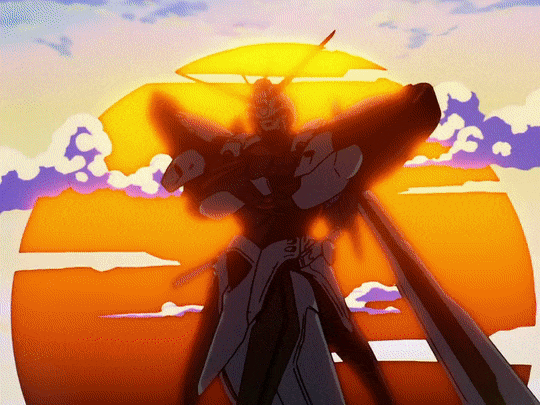
1994 would see Gundam return in a radically different form with the martial arts-inspired Mobile Fighter G Gundam. Often considered to be the other iconic series of Yasuhiro Imagawa, G Gundam would mark the beginning of a new era of Gundam by being the first alternate universe series to exist, thus allowing the franchise to flourish while letting the original Universal Century timeline continue to exist and get its own stories. Because of its radically different nature though, G Gundam is oftentimes looked down upon as a series that spits on the legacy of the Gundam franchise.
And again, not to toot my own horn here, but I also have a trilogy of posts all talking about G Gundam. All three posts seemed to be pretty popular relative to my other posts, so there seemed to be something in them that resonated with a lot of readers.
New Mobile Report Gundam Wing (1995) & New Mobile Report Gundam Wing: Endless Waltz (1996)

Following on from G Gundam is 1995's New Mobile Report Gundam Wing, which is arguably the most important Gundam series after the original and Gundam Seed in the 2000's. As a return to the war stories of the original Gundam, the reason why this series is important is because Gundam Wing would be one of the big four anime series that would make anime become mainstream in the West.
In my opinion though, Gundam Wing's legacy begins and ends with it being the first Gundam series to air in the West. In Japan, another series would air at around the same time as Gundam Wing, one that would loom over the rest of canon of mecha due to its impact on the anime industry and Japanese pop culture as a whole.
Neon Genesis Evangelion (1995) & The End of Evangelion (1996)

Ah yes, the original "Not Like the Other Girls" mecha anime.
The series that would hamper a lot of Gundam Wing's cultural impact would be Hideaki Anno and Studio Gainax's legendary Neon Genesis Evangelion, and the second of Gainax's Big Four alongside Gunbuster. Created as an homage to shows like Ultraman and Space Runaway Ideon, Evangelion would take the zeitgeist by storm, forcing its way into the pantheon of the mecha canon like... well, like an Evangelion Unit tearing through an Angel's AT Field. There was a certain je ne sais quois to the series that made it stick to a lot of viewers at the time, and a lot of the history and context behind this series' production would help shape a lot of its more cerebral moments.
Anno would eventually revisit this series in 2007 by remaking this anime series into a quartet of films known as the Rebuild of Evangelion series. At first just a project to bring Evangelion to the 21st century, the Rebuild films would eventually become the first of the Shin Japan Heroes Thematic Universe, which would come to also include:
Shin Godzilla (2016)
Shin Ultraman (2022)
Shin Kamen Rider (2023)
The problem with a series like Evangelion is that, while it is a culturally important series that deserves a lot of the attention and praise it gets, a lot of Evangelion fans tend to go a little bit too far. It's subversive nature tends to become exaggerated to the point where Evangelion is often treated as being subversive of mecha, and thus, not like the other mecha shows. This is, in large part, why the infamous idea of Evangelion being "Not like other mecha shows because it deals with character drama" comes from, and it's something that I'd like to talk about at some point in the future after all of this.
Conclusion
And there you have it! As we get into the latter half of the 90's, we will see a lot of iconic mecha shows begin to pop up. We will also see [adult swim] begin to really play its part in making anime more mainstream, along with Gundam begin to decline and the end of the Brave franchise. We'll also see the appearance of the crazy man known as Tetsuya Takahashi make his directorial debut in what is quiet possibly the single most ambitious JRPG project of all time along with a surprise appearance by... LEGO?!
Next time, Part 4.2: A Grand Glorious Gathering!!
This will be the key to victory.
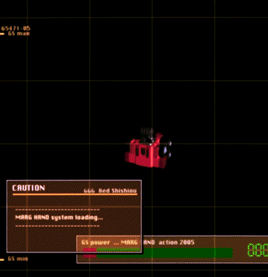
#anime and manga#mecha#mobile fighter g gundam#brave exkaiser#magic knight rayearth#giant robo ova#giant robo the day the earth stood still#patlabor#patlabor 2#power rangers#super robot wars#super robot taisen#new mobile report gundam wing#gridman the hyper agent#neon genesis evangelion#an abbreviated history of mecha#superhuman samurai syber squad#denkou choujin gridman#kyoryu sentai zyuranger
37 notes
·
View notes
Text
Cartoons With Continuity (Overarching, Season-Long Arcs, Partial, Multi-Part Eps, Etc.) That Came Out Before Avatar: The Last Airbender (2005)

1980s
• G.I. Joe: A Real American Hero (1983)
• The Transformers (1984)
• Thundercats (1985)
• The 13 Ghosts of Scooby-Doo (1985)
• Jem and the Holograms (1985)
• The Adventures of the Galaxy Rangers (1986)
• Ducktales (1987)
1990s
• The Pirates of Dark Water (1991)
• The Legend of Prince Valiant (1991)
• The Adventures of Tintin (1991)
• Batman: The Animated Series (1992)
• X-Men: the Animated Series (1992)
• The Animals of Farthing Wood (1993)
• Exo Squad (1993)
• Sonic the Hedgehog (1993)
• ReBoot (1994)
• Iron Man (1994)
• Gargoyles (1994)
• Spider-Man (1994)
• Beast Wars: Transformers (1996)
• Todd McFarlane's Spawn (1997)
• Men in Black: The Series (1997)
• Princess Sissi (1997)
• Silver Surfer (1998)
• Batman Beyond (1999)
• Roswell Conspiracies: Aliens, Myths and Legends (1999)
• Cybersix (1999)
Early 2000s
• Jackie Chan Adventures (2000)
• Chris Colorado (2000)
• As Told by Ginger (2000)
• Justice League (2001)
• He-Man and the Masters of the Universe (2002)
• Codename: Kids Next Door (2002)
• Teenage Mutant Ninja Turtles (2003)
• Teen Titans (2003)
• Code Lyoko (2003)
• Lilo & Stitch: The Series (2003)
• Xiaolin Showdown (2003)
• Star Wars: Clone Wars (2003)
• Winx Club (2004)
• Danny Phantom (2004)
• Justice League Unlimited (2004)
• The Venture Bros. (2004)
• Super Robot Monkey Team Hyperforce Go! (2004)
• W.I.T.C.H. (2004)
• American Dragon Jake Long (2005)
#cartoons#avatar the last airbender#disney's gargoyles#teen titans#fandom#my posts#I know that I missed some so...#wip.
34 notes
·
View notes
Text
Doraemon Movies Ranked by Shizuka's Roles in Them

I've written before about how Shizuka seems underutilized in many of the Doraemon movies, but not all of the movies are made equal. To get a sense of which films portray her the best, I've ranked them based on her characterization and narrative role in each one.
Obligatory disclaimer that this is not derived from any type of standardized rubric or quantitative analysis, only my personal judgment and impressions of the franchise. In addition, this list is distinct from how I'd rank the movies based on my opinion of their overall quality and entertainment value. In general, increased focus on Shizuka (or any of the other main characters) is almost always a positive for me, but there are certainly Doraemon movies that I think are good yet don't feature her prominently, or ones that I don't enjoy as much even though they manage to portray her well.
Full ranking below the break. I've also linked to my reviews of each individual film to provide further context. May contain movie spoilers!
1. Nobita's Three Visionary Swordsmen (1994)
In many ways, this is Shizuka's movie. She has an active role for much of her screentime, undergoes the most personal journey, and is the one who finishes off the main villain. Furthermore, she gets moments to show that she's clever, works hard, and values kindness. Her key role is all the more remarkable considering that she doesn't "properly" join the main plot until nearly halfway through the movie.
Reinforcing her position as the central character is the fact that in the beginning of the movie, Nobita imagines himself as a hero who hides his true identity from his friends, but during the actual adventure, it's Shizuka who maintains a secret identity. It's a fun way to play with audience preconceptions.

2. Nobita and the Steel Troops (1986) 3. Nobita and the New Steel Troops (2011)
Shizuka is a major player in this story as well. Here, her foremost traits on display are her compassion and willingness to forgive, but that's not all. It's her knowledge of Doraemon's gadgets that provides a solution to the main conflict, and as I've previously written, it's also one of the few times that her kind nature is actually tested. Her precocious declaration that "Doing things that don't always make sense is being human" may be one of her best-known lines in the franchise, and for good reason.

None of the Doraemon movie remakes change Shizuka's roles enough to be given vastly different rankings from their original counterparts in my opinion, but if I were to compare the two different versions of Steel Troops, Shizuka's goodwill arguably shines even more in the original, considering that she was still determined to save Riruru after the robot made an attempt on her life (a scene cut from the remake)!
4. Nobita's Little Star Wars 2021 (2022) 5. Nobita's Little Star Wars (1985)
This story has one of the few "Shizuka gets kidnapped" subplots that I can actually tolerate, and a major reason why is that she is very actively involved with the rest of the narrative. From the moment that she's drawn into the main conflict, she does everything she can to help, despite admitting to having doubts and fears of her own. Her determination even ends up inspiring Suneo's own acts of bravery, and speaking of which, this is among the few Doraemon stories to showcase the dynamic between the two of them.

Comparing the remake and the original in this case is difficult, because beyond the scenes that they share, the two versions highlight different aspects of Shizuka's character. The remake heightens her positive qualities even more (the addition of her forcibly stopping Papi from turning himself in to the antagonists feels very in-character), but seeing her being a little self-centered during the movie-making subplot at the beginning of the original is kind of fun, too.
6. Nobita and the Castle of the Undersea Devil (1983)
Once again, Shizuka's kindness towards another character becomes an overarching subplot that is critical to saving the day. Furthermore, though this was the first Doraemon movie to use the "Shizuka gets kidnapped" plot point, it's an interesting version of it in that she volunteers to be captured as part of her plan to locate the main villain's hideout.
And what's her reaction to an unreasoning AI threatening to rain nuclear destruction on the world?

(Using a panel from the manga here because available English fansubs don't translate this line properly. It is in the movie though!)
7. New Nobita's Great Demon (2014) 8. Nobita and the Haunts of Evil (1982)
Although this story doesn't focus on Shizuka as much as the last few, she has a very important part in it, given that her realization about how the prophecy of the dog kingdom can be fulfilled is the key to the heroes' victory. Also, she beats up a gorilla and has fun doing it.

Her role is essentially unchanged across both versions of the movie, but I'm ranking the remake higher just for being a better-made film overall. In addition, she is careful to avoid actually hurting the gorilla in the remake, which seems like something she would do.
9. Nobita's Chronicle of the Moon Exploration (2019)
This is another movie in which Shizuka is not the focal character, but really comes in clutch at the end when the others need her. In general, giving her free rein to Doraemon's gadgets (as also occurs during key moments in Three Visionary Swordsmen and Steel Troops) is a good way to ensure that the day gets saved.
10. Nobita's Dorabian Nights (1991)
I give this movie a lot of flack for how nonsensical its story is and how excessively cruel it is to Shizuka. (Being trafficked as a slave due to her friends' thoughtless actions? What the hell?!) However, I have to admit that Shizuka herself is written quite well. She stays remarkably composed and sticks to her principles in the face of calamity, even when her prospects of rescue seem vanishingly remote. She is also resourceful enough to come up with a fairly credible escape plan, though it doesn't work out. She gets out of a hostage situation on her own during the climax, so that's something.
At the same time, she avoids coming across as unrealistically perfect, because the movie also gives her a few moments to be flawed: she can be short-tempered (snapping at Nobita for inviting her over for "kids' stuff"), and even a bit careless sometimes (remembering the wrong date for her camping trip)!

11. Nobita's Sky Utopia (2023)
Speaking of flaws, this next entry is one of the few movies to highlight Shizuka's. Here, it zeroes in on the fact that she can be stubborn, which many viewers might not have picked up on, but is very much a consistent part of her character. (Just consider how she insists on taking daily baths, no matter where she is and how inconvenient it might be.) As mentioned in my review, the film doesn't do as much with Shizuka's stubbornness as I would have liked it to, but the fact that it was put in the spotlight at all is still noteworthy. Not to mention, the scene where Shizuka, Gian, and Suneo own up to their flaws is one of the best in the movie.
That being said, the fact that this is enough to nearly qualify in the top 10 film depictions of the third most important character in a franchise with over 40 movies... is a little sad, isn't it?
12. Nobita and the Kingdom of Clouds (1992)
Although it doesn't achieve much, Shizuka does get a good character moment here when she's the only one of her friends to come up with a cogent, calmly stated argument (with minimal preparation, no less) in attempt to persuade the sky people not to follow through with their plan to flood the Earth.
She is also shown to be a good artist—check out her freehand design of this castle.

13. Nobita's Diary on the Creation of the World (1995)
Due to time constraints, a substantial portion of Shizuka's activities in this one happens offscreen, but what little we get to see shows that she apparently accomplished a lot! On top of that, she formulates a plan that helps Doraemon and Nobita subdue a giant centipede, and her artistic and note-taking skills come in handy for putting together their school report.
14. Nobita and the Birth of Japan (2016) 15. Nobita and the Birth of Japan (1989)
The opening act of this story is interesting for the insight it provides into each of the main characters. It probably isn't much of a surprise to see Nobita or Gian wanting to run from home, but why might a rule-abiding, responsible kid like Shizuka consider doing so? Well, like many other children who get branded as "well-behaved", it turns out she feels a fair bit of pressure from parental expectations.
She doesn't have much to do in the story after that, but to be fair, no one really does in the original movie. Everyone gets to contribute more in the remake, giving it a higher ranking by default, though Shizuka arguably still lacks a real standout moment to shine.
16. Nobita's New Dinosaur (2020)
Shizuka's most prominent moment in this one is probably the scene where she gives a motivational speech to Nobita. It's not much, but it's pretty sweet, actually. Otherwise, she does enough to maintain an active presence even when the spotlight isn't on her.
17. Nobita's Secret Gadget Museum (2013)
Another entry in which Shizuka doesn't get a whole lot of focus, but is involved enough to feel present. She defeats a petrifying Gorgon Head statue and locates a secret passageway. Also, seeing her get to laugh along with her friends is cute.

18. Nobita's Space Heroes (2015)
This is a hard movie to rank, because Shizuka contributes quite a lot during the action sequences and even takes down one of the major villains by herself. However... this is offset by how much the film seems to water down her characterization. Like I mentioned in my review, it's odd and inconsistent with her previous depictions that she would feel embarrassed about using her gadget-augmented strength. And at one point, she out of everyone in the group even admits to having forgotten about Nobita (who had last been seen in a life-threatening situation)!

As @filmfactors discussed in their own musings on Shizuka's characterization, there's also something lackluster about the fact that she's given water powers simply because she likes bathing (to the point where she's given a line to lampshade this). It's not so much that hydrokinesis doesn't work for Shizuka as a superpower—I actually think it'd be very appropriate for her to receive a power that would seem to require substantial mental and technical skill to use, and at the same time has immense destructive potential if not properly controlled. (Even though I know very little about X-Men, this is also why @cosmicmaskman's casting of Shizuka as Jean Grey feels very fitting to me.) I just would have preferred if it had been connected more to her actual skills and personality.
19. The Records of Nobita, Spaceblazer (1981) 20. The New Record of Nobita's Spaceblazer (2009)
This is an unusual story in that Shizuka isn't in much of it (and neither are Gian and Suneo, for that matter), which prevents me from ranking it higher. She does at least have a moderately prominent role during the screentime she has, acting as a mediator among her friends and convincing Gian and Suneo to help out during a crucial moment.

I place the original movie higher than the remake because I think it's generally better executed, but Shizuka's role is pretty much the same in both. As a bonus, the original includes one of the few times that she is shown playing baseball with the others.
21. Nobita's Earth Symphony (2024)
As said in my review, for a story about music, this movie met my bare minimum expectations for Shizuka's level of participation. She actively contributes throughout the narrative and her established experience with musical instruments is acknowledged. Even so, more could have been done with her. A gag where she volunteered to play the violin only to be stopped by the rest of the group would have been so easy!
22. Nobita and the Animal Planet (1990)
Although not much attention is drawn to her, Shizuka has a decent presence in this one. She's shown to be supportive of Nobita when Gian and Suneo make fun of him (but isn't above teasing him a little herself), figures out the explanation behind the animals' creation myth, and gets to help out in small ways here and there (at least as much as Gian and Suneo do).
23. Nobita and the Legend of the Sun King (2000)
Shizuka doesn't do very much here, but she contributes at least one thing of narrative importance. Her getting angry at Prince Tio is one of the main events that leads him to rethink his behavior and inspires his character development. She also pieces together what the villain's plan is (earning her a compliment from the villain), and seeing her play the prince in Snow White is a fun moment if nothing else.

24. Stand by Me Doraemon 2 (2020)
Given that this movie is about Shizuka and Nobita's wedding, she naturally has a major role in it. Yet half the time she feels more like a prop for Nobita's character development. Doing nothing but wait for a whole year after he mysteriously disappears from their wedding ceremony? Standing around while her friends desperately fight some older bullies, instead of trying to get help?
She does get a few moments to be an actual character though: she stands up to the aforementioned bullies (though understandably can't do much about them), and she proves to be perceptive, as at the end of the movie she figures out based on very few context clues that adult Nobita had gotten help from Doraemon.
25. Nobita and the Spiral City (1997)
Being kind pays off once more for Shizuka, as it leads a secondary antagonist to act in her (and her friends') favor at a critical juncture. Although important, neither this concept nor Shizuka herself are given nearly as much time or focus as they were in previous stories that used similar plot points, such as Castle of the Undersea Devil or Steel Troops.
26. Nobita and the Galaxy Super-express (1996)
Here, Shizuka makes the valuable discovery that the alien antagonists are vulnerable to soap solution. Like I commented in my review, this mainly seems like a contrived way to justify showing her in a bath scene though, so... ugh.
27. Nobita's Dinosaur (2006) 28. Nobita's Dinosaur (1980)
There isn't much in the way of practical contributions from Shizuka (nor from Gian and Suneo) in this earliest of the Doraemon long stories. Still, she has enough screentime to establish her general personality. She's nicer to Nobita than Gian and Suneo are, but at the same time doesn't always have much faith in him either. She worries about not being able to finish her homework when Doraemon suggests turning their journey to the Cretaceous into a camping trip, and she puts herself at risk to try and save a baby sauropod from a Tyrannosaurus rex.
The remake gives pretty much everyone a characterization boost, so it gets a higher ranking than the original from me. Perhaps the most noteworthy addition for Shizuka is her argument with Suneo over whether they should hand Piisuke over to the dinosaur poachers.
29. Nobita and the Tin Labyrinth (1993)
There's very little for Shizuka to do in this one, but seeing her being a bit competitive and accepting a bet from Gian and Suneo is at least an interesting character moment. (The manga did it better though.)
30. Nobita's Treasure Island (2018)
I already spent too many words dissecting Shizuka's subplot in my review of this movie, but to summarize: for the amount of screentime she gets, it really doesn't do her many favors. She barely contributes to resolving the main conflict in any meaningful way, nor is there much insight into her character that you normally wouldn't get. The friendship she strikes up with Sarah is cute, I suppose. If only it mattered more to the story.

31. The Record of Nobita's Parallel Visit to the West (1988)
The main thing Shizuka does in this movie is play the part of Tang Sanzang. Unfortunately, playing the part of Tang Sanzang also means not doing very much other than getting captured by monsters.
32. Nobita and the Knights on Dinosaurs (1987)
We're running out of notable movie roles for Shizuka at this point in the list, but there are a few character moments here at least. She plays her violin for the first time in a Doraemon movie, gets praised by Gian for being smart, and spots the approaching bolide that will cause the end-Cretaceous mass extinction (though no one listens to her). There's an odd scene that implies she is jealous when Nobita crushes on Roo the dinosauroid girl.

33. Nobita and the Winged Braves (2001)
This would have been the perfect story for the filmmakers to remember that Shizuka has a pet bird, which they do. Her pet even ends up in the bird dimension alongside the main characters. The movie then proceeds to do... absolutely nothing interesting with this concept. Considering that the relationship between humans and birds is a major theme here, it would have been a great opportunity to use Shizuka and her canary to make some form of commentary on this topic, but no.
To add insult to injury, Shizuka doesn't participate in the big race that occurs halfway through the movie, and gets sidelined during the climax.
34. Nobita in the Wan-Nyan Spacetime Odyssey (2004)
Shizuka, uh... drives a truck in this one. I guess that's something.

35. Nobita's Great Adventure in the South Seas (1998)
She helps fight the villain's bioengineered monsters during the climax, but that's about it.
36. Nobita Drifts in the Universe (1999)
Along with Gian and Suneo, she helps hold off enemy forces during the climax, but this occurs almost entirely offscreen. She also gets some surface-level bonding with Freya the alien fairy so the latter can feel guilty about betraying the heroes later.
37. Nobita and the Windmasters (2003)
This movie does many things very well, but giving Shizuka meaningful focus is not one of them. She gets a couple of cute scenes here and there, and helps rescue Fuuko, which amounts to nothing because Fuuko gets recaptured almost immediately afterward.
38. Nobita's Great Adventure in the Antarctic Kachi Kochi (2017)
Outside of some general participation in group scenes, Shizuka is nearly a background character here.
39. Nobita in the Robot Kingdom (2002)
Another one in which Shizuka is largely relegated to the background. What's sad is that if the film had followed the manga's version of events (as discussed in my review), it almost certainly would have placed in the top 10 of this ranking.
40. Nobita and the Island of Miracles (2012)
Could the filmmakers really think of nothing else for Shizuka to do during the climax other than using the ethically dubious Cheerleader Gloves?
They did try to give her a good moment in this movie by having her sharply rebuke Nobita for panicking over not having access to Nobita's gadgets. I guess it's meant to show her staying resolute and level-headed during a crisis, but as I commented in my review, this didn't really work for me as it feels very uncalled for in the context of the story.

41. Nobita and the Green Giant Legend (2008)
I can barely remember anything Shizuka did in this movie. In fairness, that's also true for everyone else besides Nobita.
42. Nobita's Great Battle of the Mermaid King (2010)
The most focus that Shizuka gets here is another excessively cruel subplot about her getting kidnapped and held hostage, which doesn't even do much for the narrative besides extend the runtime of the movie. The brief moment in which she body-slams one of the villain's minions during the final battle doesn't quite make up for it.
43. Nobita's Great Adventure into the Underworld (1984) 44. Nobita's New Great Adventure into the Underworld (2007)
Shizuka's role in this story is mostly limited to being on the wrong end of a running "joke" about her underwear being repeatedly exposed. Any minor contributions that she does get to make could have been given to other characters or written out with little impact on the overall story.
Astoundingly, the remake manages to make the panty shot "jokes" even worse.
45. Stand by Me Doraemon (2014)
A movie about Shizuka being gaslit, emotionally manipulated, and treated as a trophy. No, thank you.
13 notes
·
View notes
Text

Adventures of Superman #514 (July 1994)
"THE FALL OF METROPOLIS," Part 4! Metropolis is invaded by aliens! And werewolves! And Nazis! And Lois Lane dies! And Professor Hamilton loses a limb! Only one of these things ends up being true by the time the issue is over.
Metropolis is still in ruins after the explosive events of Action #700 (it's not like they can magically fix it from one issue to the next, right?) and on top of that, the city is now covered in so much fog that it's giving me Superman 64 flashbacks. But this is no regular fog: when some armed preppers walk through it, one of them suddenly hallucinates that his friends are alien invaders and kills them in a panic. Elsewhere, three soldiers are affected by the fog and start seeing everyone around them as "commies," the Viet Cong (so "commies" again), and werewolves (communist ones, presumably).
Superman stops a soldier from shooting a rabbi/imaginary werewolf, but the soldier sees him as a vampire while the rabbi thinks Superman is a Nazi (both solid Elseworlds premises).
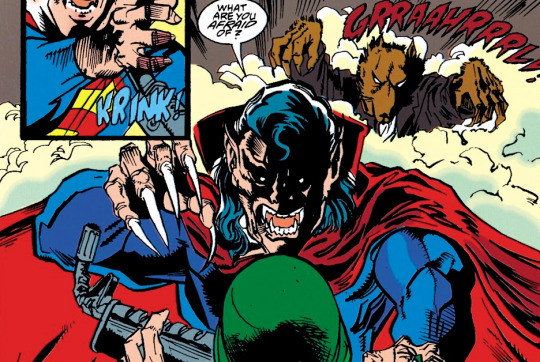
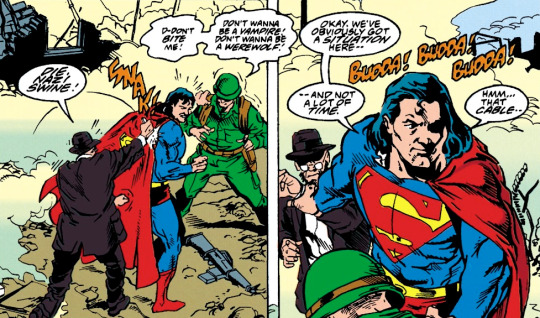
While trying to contain all the people tripping balls around Metropolis, Superman runs into Lois, who's just chilling in the middle of the ruins. Just as Superman comments that he seems to be immune to whatever is making people hallucinate their worst fears, that trigger-happy prepper from before appears and shoots at them, thinking they're aliens (well, he's half right).
Superman just lets the bullets bounce off his chest... not noticing that one bounced in Lois' direction, fatally injuring her. NEXT: Reign of the Lois Lanes?!
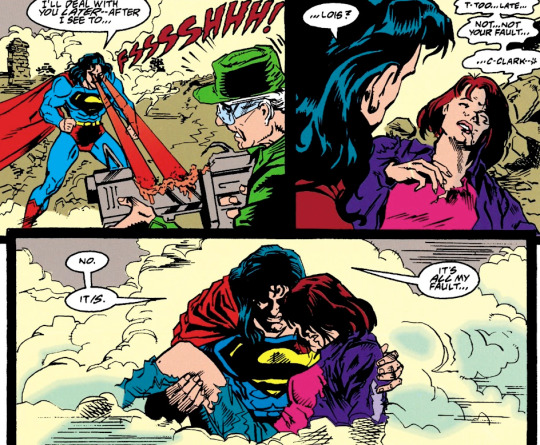
Making matters worse, Ma and Pa Kent happen to stroll by, having seemingly traveled to war-torn Metropolis just to tell their son what a disappointment he is. Then Lex Luthor shows up too, with his luscious red locks inexplicably restored, and tells Superman none of this would have happened if he hadn't stolen Lois and Metropolis from him. Lex finally concedes that Metropolis is "Superman's city," but only because, as Superman just noticed, the city is full of nothing but corpses now.
Meanwhile, Professor Hamilton is having a tough time too: a prostitute has just shot him in the arm because she hallucinated that Hambone was her abusive pimp. Hamilton is rescued by a white-haired young lady who smacks the prostitute with a plank of wood. Ham and the girl jump into his car to escape the crazed crowd around them, but then he hallucinates his worst fear: not being able to operate a vehicle because the controls are too complicated.
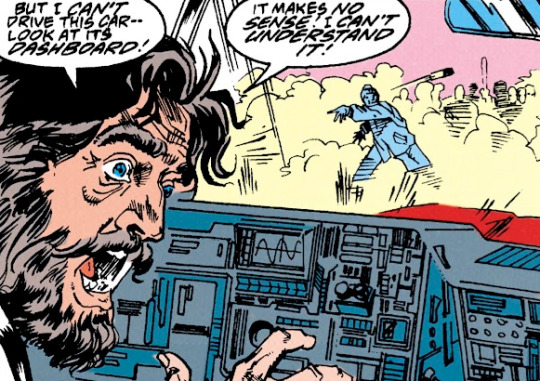
"Also, I'm naked!"
The girl jump-starts the car's engine and they speed away from the crowd -- only to realize that being in a speeding car with someone who's hallucinating at the wheel isn't such a brilliant idea. They end up driving the car off a pier, and right before they do, we see that Ham happened to have a box full of something called "synthetic enzymes" on his back seat...
Back to Superman, he angrily flies into the sky with Luthor, who morphs into his old school bald self and goads Superman into killing him. Superman refuses to give in to hatred and delivers a speech about rebuilding a better, Lex-free Metropolis, causing Luthor to fade away, as does Lois' corpse. Right then, Hamilton and the white-haired girl come to tell Superman that they've figured out how to stop the hallucinations: no, not "facing and overcoming your deepest fears," but simply spreading that convenient "synthetic enzyme" throughout the city to negate the fog's effect.
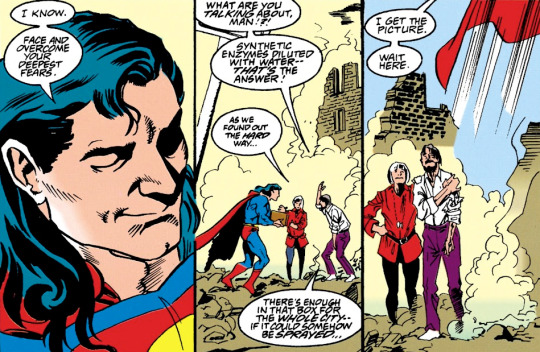
(This is why I never leave the house without synthetic enzymes in my car since reading this issue.)
Superman makes the enzyme rain down over Metropolis and everything goes back to normal... except for Professor Hamilton who, to quote Arrested Development, is now "all right," because he lost his left arm. Superman and Hamilton figure out that the crazy fog was another one of Luthor's "fail-safes" in case he was ever defeated, like the killer robots that have been attacking Metropolis over the past weeks (Man of Steel #35 and Superman #91).
But there's still one fail-safe left, and it's a big one...
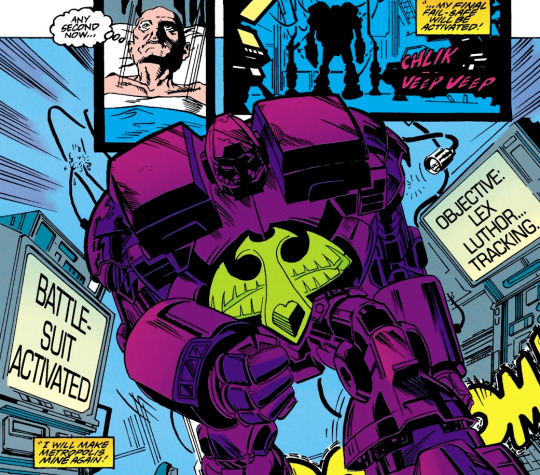
TO BE CONCLUDED!
Creator-Watch:
This month's issue of Adventures is guest-drawn by Peter Krause, who coincidentally also guest-drew Adventures and Superman exactly two years ago during the Agent Liberty two-parter. We'll see a little more Krause in the near future via another Adventures issue and the Metropolis S.C.U. miniseries… and maybe a LOT more in the not-so-near future if our plans to cover his Power of Shazam! ongoing series with Jerry Ordway in our newsletter come into fruition. (Don is a big fan and I've always been curious about it because 1) it's Ordway and 2) José "Gangbuster" Delgado is in it.)
Plotline-Watch:
The loss of Professor Hamilton's arm will be the longest-lasting consequence of Metropolis' destruction. (It will also be used to turn him into a villain after this era, but we won't be covering those issues and I'm glad.) I like that good ol' Ham is so absent-minded that he seems to have forgotten about his missing arm like five minutes after they amputated it. He also forgot that his hair is supposed to be grey, apparently.
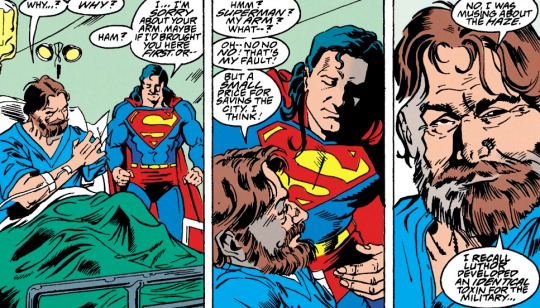
There's a dark irony to Hamilton losing a limb after being shot by a prostitute, considering that Adventures #425, his second appearance, was about him kidnapping a "strumpet" at gunpoint out of desperation after Luthor stole his invention. He did his time and got his shit together after that, though.
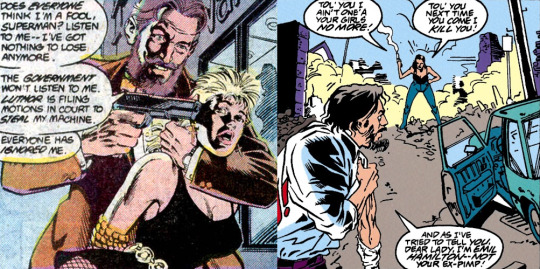
Yes, Luthor's final fail-safe is the Awesome Kryptonian Battle Robot, which was built in ancient Krypton, sent to the Phantom Zone, ended up in the Fortress of Solitude (where Professor Hamilton used it to play tag with robots), and was most recently used by the powerless, recently resuscitated Superman to walk from Antactica to Metropolis during "Reign of the Supermen." I guess Superman sorta lost track of it after that, but to be fair he did have a lot on his mind at that point.
At S.T.A.R. Labs, Dr. Kitty "Rampage" Faulkner tells Superman that right before Project Cadmus was destroyed (as far everyone knows, anyway), they used some fantastic sci-fi technology called a "modem" to send S.T.A.R. their info on the cure to the Clone Plague. Despite Luthor being a dick in and out of Superman's hallucinations, Superman still makes sure he's delivered to S.T.A.R. at the end of the issue so they can apply the cure (though we already know he won't stay there for long).
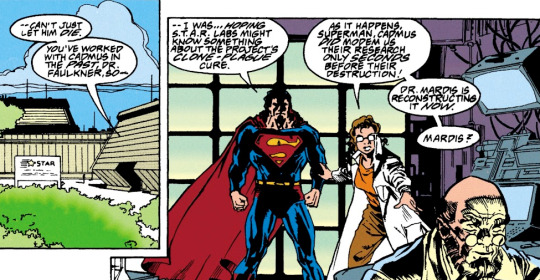
"Mardis" up there is Dr. Jean Louis Mardis from the recent S.T.A.R. Corps miniseries, who is somehow still employed by S.T.A.R. despite trying to pass off alien tech as his own inventions, accidentally turning a bunch of regular people into superpowered freaks and nearly causing an AI to conquer the world. S.T.A.R., which has also employed Hamilton in the recent past, seems to be big on second opportunities.
As far as I can tell, that white-haired young lady who has a weird amount of protagonism in this issue Never Showed Up Again. [EDIT: k9feline reminded me in the comments that she DOES show up again, with her rock band! Shame on me.] Given the color of her hair, her surprising skill with machines, and the fact that she keeps calling Professor Hamilton "pops," I'm gonna assume she's supposed to be his secret lovechild (with a prostitute?).
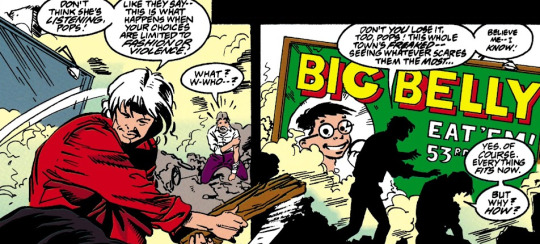
Big Belly Burger sighting! "Eat 'em!"
Shout Outs-Watch:
Big belly shout outs to our supporters, Aaron, Chris “Ace” Hendrix, britneyspearsatemyshorts, Patrick D. Ryall, Bheki Latha, Mark Syp, Ryan Bush, Raphael Fischer, Kit, Sam, Bol, and Dave Shevlin! Join them (and get extra articles) via Patreon or our newsletter's "pay what you want" mode!
And now, stick around for The Don Sparrow Show:
Art-Watch (by @donsparrow):
We open with the cover, and it’s a pretty affecting one, a pieta style pose with a massive Superman mourning an apparently grievously injured Lois Lane. Very emotional, and pretty restrained, in terms of '90s-excesses—in the hands of a lesser artist, the idea of Lois’ tattered clothes would be treated as titillating rather than sorrowful, so it’s an effective choice that Barry Kitson makes here.
The cover is all the Kitson we get, as the interiors are handled by Pete Krause, a terrific artist, and soon-to-be companion of Jerry Ordway on the excellent Power of Shazam! series. Though I think his sharpest work is ahead of him, his pencils are solid throughout this issue, an interesting middle ground between the shadowy slickness of someone like Stuart Immonen (indeed, I don’t remember Krause ever looking so much like Immonen), and the pure linework of someone like Tom Grummett. The shot of Superman rescuing the old man is a great one. Our introduction to Lois Lane in the story is also a cute panel, as Superman greets her with a (fairly wide) open mouth kiss.
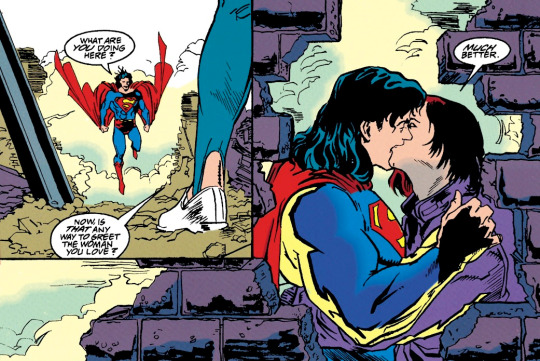
The image of Professor Hamilton getting shot in the arm is something of a mixed bag—the expression of pain is great, but it also doesn’t actually show him getting shot (the drawing appears to indicate that he was only grazed by the bullet) but we later learn that the injury is so severe his arm must be amputated. [Max: I also got the impression that the injury wasn't so severe, but the girl does mention that Ham spent "hours" looking for Superman without getting medical attention, so that didn't help.]
The smoke is well used as a framing device for the dream sequences, as both the cause of the hallucinations, and a good way of demonstrating the dream like quality that feverish fantasy lends. The panel of a majestic Lex II is particularly well done.
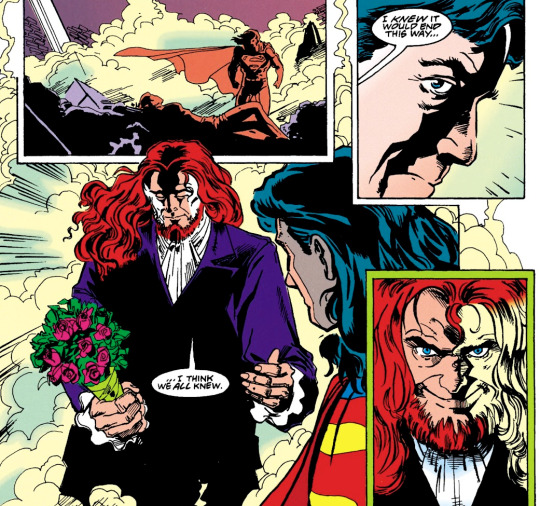
The best panel in the book might be on page 16, where an enraged Superman flies Lex II up up and away, and Lex’s roses fall to Earth, giving a real sense of height and motion.
The pages where Superman puts Hamilton’s cure into action are great, as Superman soars into action, and creates a water spout to deliver the cure.
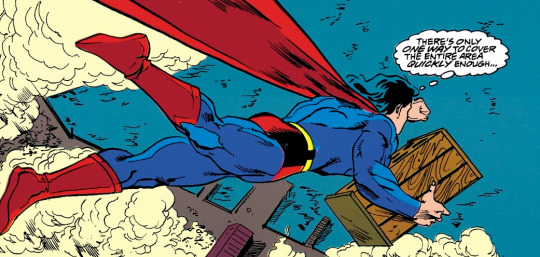
Finally, I always love seeing the Mignola-designed Kryptonian battle suit in action, and it’s an efficient piece of storytelling that Lex picked it up when it was just abandoned on the harbour in the "Reign of the Superman" storyline.
I’m not generally a fan of dream sequences as I often find them to be indulgent writing, and also inconsequential plotting—they rarely mean anything more than actual dreams do. But this issue on the whole wasn’t as frustrating as some fever dream issues can be, as Karl Kesel deftly uses Superman’s nightmarish doubts to fuel action that did matter to the plot.
SPEEDING BULLETS:
Though the film is decades away, the alien infected soldiers from Jeff Scully’s chemically induced reverie look for all the world like the Orcs from the unrelentingly terribly 2017 movie from future terrible Superman writer Max Landis, Bright.
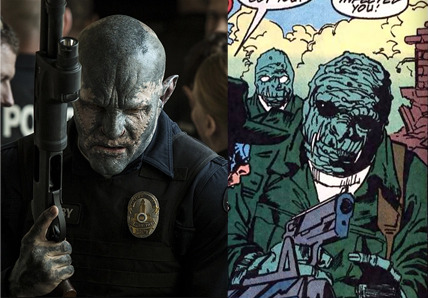
I can’t remember a time when a one-off character got so many name mentions as Jeff Scully, who gets identified no fewer than three times in the book. I wonder if it was a buddy of Karl Kesel’s perhaps. [Max: Since he's obsessed with aliens, I always took it as a little X-Files shout out.]
Then on the other end of the spectrum, we’re introduced to the lady in the headband who pulls a Thelma and Louise off a pier with Professor Hamilton, but in spite of having pages of dialogue, is never given a name, that I can find.
The “baker to alpha” soldier is a dead ringer for Pork Chop Hill era Gregory Peck, in my estimation.
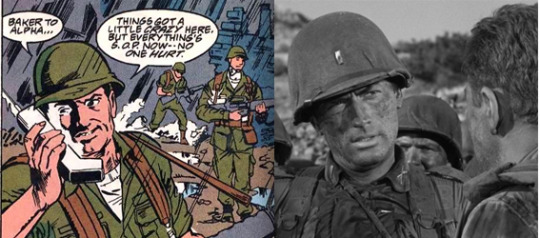
I’m not entirely sure who I’d cast as Emil Hamilton, but in the final pages of this story, he looks a lot like Awakenings era Robin Williams to me.
I had forgotten exactly how Hamilton lost his arm, I just remember that he suddenly had a robot arm. It’s a bit odd that a high tech character like him loses his arm to plain old gunfire.
Am I alone in being confused why the toxin was able to affect Superman’s super-efficient system? Though he needs to breathe, traditionally, he’d never show much vulnerability to gases in past stories. [Max: I guess it's possible that Lex intentionally designed it to be strong enough to affect Superman, and the military rejected it when they were like "uh, why does the budget include a $100 million 'Kryptonian respiratory system research' item...?"]
GODWATCH: A very overt reference to the almighty from our Holocaust survivor elderly man, thanking both God and Superman for dispelling the fear toxin—complete with a literal and symbolic rainbow after the storm.
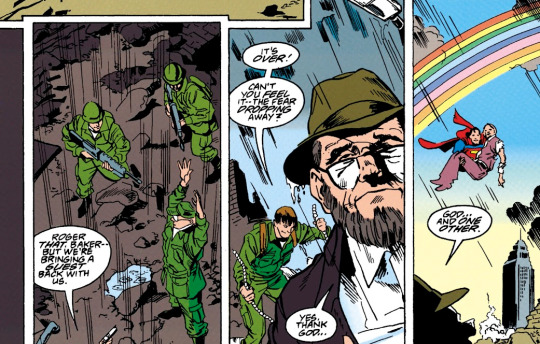
One wonders if Lex’s weaponized fear toxin was in any way based off of Batman villain Scarecrow’s concoction. Seems like a missed opportunity, though it’s a pretty jam packed issue.
#superman#karl kesel#peter krause#ron mccain#emil hamilton#kitty faulkner#s.t.a.r. labs#ma kent#pa kent#awesome kryptonian battle robot#clone plague#fall of metropolis#big belly burger#riot grrrl case#gals who DID show up again#imaginary communist werewolves
14 notes
·
View notes
Text
Lets Talk About Battletech
Felt like gushing about the one sci-fi series that I have always nerded out over, so lets talk about big stompy robot and one of the last bastions of the real-robot mecha sub-genre in this cyberpunk world we now live in.
My introduction to Battletech was the Animated series that aired for one season in 1994. It was far from the best cartoon, mostly serving as a meme generator for the current fandom. Exo-Squad was on their second season by that time and had superior animation and story telling but there was something about Battletech that kept me and my friends talking about it. That something was the Battletech universes itself. As flawed as the cartoon was, it did a great job summing up the Inner Sphere in it’s 60 second intro. The show leaves out a lot but if it’s mission was a simple introduction, sampler to the much broader Battletech Universe, mission accomplished.
After the cartoon ended, my buddies found the Battletech novel series at the local book store, that lead us to find the Battletech 3rd edition table top game and in 1995, Activsion published MechWarrior 2: 31st Century Combat. After that, I was unapologetic Battletech nerd.
What was it that made me fall in love with the game? Allot of little things. The ‘Mechs that took center stage in Battletech had wight, they looked and felt like combat machines. Each Battlemech looks purpose built for war, walking weapon platforms that would crush foes under foot given the chance. The stories themselves are not award winning but most are relatable. Each conflict has petty beginning and costly consequences. Few things are black and white, war itself was the enemy but was also celebrated. Each character had their own self serving motivations rather than some altruistic idea, be it seeking honor and glory or avenging their home planet lost to conflict. It wasn’t ultra-bleak like 40K but it was acknowledging there is little black and white in war, just allot of gray. You are piloting a towering killing machine and winning sometimes means just getting back alive after you run out of ammo, your armor has been shredded and the other mechs are hunting you down.
As with any community built around a war game, you do run into occasional jerks you need to block but I found most of my interaction with fellow Battletech fans to be good ones. Some of my most cherish from my childhood was playing the table top with my school yard friends or talking about that stupid cartoon. Made new friends simple sharing Battletech fan art and still enjoy talking about Battlemechs with my current social group when I can.
Coming full circle; If that stupid, stupid cartoon can teach us anything, don’t be petty. It’s far easier to make enemies than allies and in this world of gray, do the right thing when you can… that and Nicolai Malthus was an ass... sorry Jade Falcon fans but you know why he’s the meme.
87 notes
·
View notes
Text
Sega Mega Drive - Rockman Mega World (Mega Man: The Wily Wars)
Title: Rockman Mega World / ロックマンメガワールド
Developer/Publisher: Capcom / Minakuchi Engineering
Release date: 21 October 1994
Catalogue No.: T-12053
Genre: Compilation / Action

A remixed version of the first three Rockman/Mega Man games originally from the Famicom that has shaped an entire generation of gamers, now ported to the Mega Drive with enhanced graphics and sound, plus a new Wily Tower mode. The weird thing is that it was released in North America as well in 1994, but only via the Sega Channel broadband download service. The PAL version of this only runs at 50hz. My Japanese copy runs at full 60hz thankfully.
The overall look of the game is not a straight-up splash of paint but carefully reworked graphics that improve the presentation of the screens and menus, add mugshots of the first six robot masters, and add parallax scrolling backgrounds to the levels. Pairing with the new look are stunning recomposed music tracks and new exclusive tracks, both very faithful to the mood of the game.
The controls are comfortable to use and can be configured. It's nice to be able to open the weapon selection window with the press of one of the three buttons instead of the Start button. And speaking of configuration, you can also use the options menu as your own personal Mega Man jukebox. The ability to save the game after completing a level is a plus compared to writing down and entering passwords.
The great reward for finishing all three Mega Man games is the Wily Tower (which could be coined as Mega Man 3.5). Since you can choose any combination of eight weapons and two utilities, this means there are multiple methods and paths to take for that glorious replay value. Since then, there has been a re-release of this game via Retro-bit, the Sega Genesis Mini has it as well, and there is a fan-made continuation of this called Mega Man Sequel Wars.
My copy also came with this little photo-copy of the Retro-Bit Collectors' Edition front. I'm sure you'll like it.





youtube
2 notes
·
View notes
Note
something it occurred to me to wonder recently and thought if anyone would know, it would be you ;p
when Eva began back in 1995, how much was it anticipated? both narrowly in otaku circles, and more widely among 'people who watch TV in Japan'? as far as i understand the history, Gainax was pretty niche back then and mostly known for dating sim games, but the visual style of Eva is so immediately striking...
like, I know nobody quite realised just how huge it would become, but was there some sort of excitement for a new robot anime from the people who made Wings of Honneamise, Gunbuster and Nadia? or was it a complete surprise?
Hm, good question! I am not super confident in my answer, so my bet is "highly anticipated but not crazily so". Gainax was known but niche, having 'Otaku' success with as you mention Wings and Gunbuster...until Nadia: Secret of Blue Water came out in 1990. This would not have put Gainax per se on the map, as Toho and Group Tac were branded as the primary producers, Gainax as secondary, but it definitely put Hideaki Anno on the map as director. The show was wildly successful, aired in prime-time slots - which, fun fact, meant that its first season airing was interrupted due to breaking news about the onset of the First Gulf War - and Nadia herself became Best Girl in most of the Newtype/Animage style polls of the time until being dethroned by Sailor Mercury in 1992. Nadia was definitely still 'an anime', and it was a kids show in too many ways to be a real breakout. But it was the top of anime of its time, no debate.
Its success is what gave Anno the ability to finance Evangelion, and it meant he was also able to pull a lot of 'big talent' for branding purposes - which ofc was intentional, Anno is no fool. Hiring Usagi from Sailor Moon's voice actress Kotono Mitsuishi to be Misato for example, when Sailor Moon was the #1 anime of 1994, is certainly because of her talent but also because of her buzz, and he has a bunch of hires along those lines to make Eva the "oh man the best of the best are all here" kind of show.
(Again fun fact time - you prob know this one - he also tried to bring Kunihiko Ikuhara, Sailor Moon director, onto the animation staff, and as part of his tactics to woo him named Rei Ayanami after Sailor Mars, Ikuhara's favourite SM character that he famously cosplayed. Ikuhara was alas too busy with wrapping up his time on Sailor Moon and forming Be-papas to make Utena to spare the time)
All this meant that by the time Evangelion was getting ready for its Fall 1995 debut, the cover of the April 1995 issue of Newtype looked like this:

And hey, if you want some evidence of the buildup discussed, the first page of the cover feature starts off in 1990, with a discussion of the impact of Nadia:
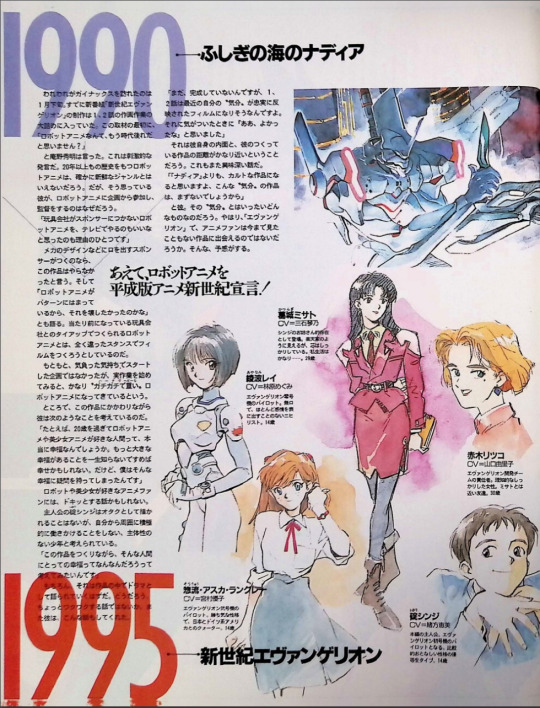
Even here, once it transitions to discussing Evangelion, Anno is promising "something anime fans have never seen before". It was a common refrain in all the marketing material throughout 1995, that this show was going to be special. The manga adaption actually began print in February of 1995, as a hype builder. The Evangelion team was putting it all on the line.
Also I love that early concept art - the more gundam-esque pilot suits over the plugsuits would have absolutely been my jam, alas.
(This marketing material is more evidence against the mythical "mid-production pivot" theory that fans in the past surmised about Eva's intended story, but a topic for another time)
Still, this is just marketing - who wouldn't say your show will Change Everything, that is your job as a business! For all the inner-otaku hype and rep, Evangelion was definitely targeted at those otaku, and it wasn't marketed to an all-ages demo with wider appeal like Sailor Moon. Anno even remarks in the interview above it would be more of a 'cult hit' compared to Nadia. It had a Wednesday airing slot (at 18:30, not actually super late - another myth, it just had late night re-runs after its evening air slot), not a great time and definitely not a Saturday evening slot like Sailor Moon.
It was a show that instead grew over its airing and broke out of its slot and genre - its finale got audience ratings almost twice that of its premiere (though these numbers are hard to aggregate over different stations). Its about midway through its run that you start getting those "phenomenon of Evangelion" style articles, and when the ending hits the culture critics start jumping in as well and it becomes a true cultural event, and discussion of the show in mainstream magazines starts happening. That wasn't happening in 1995.
I wish I could say it all culminates with End of Evangelion being released and being the #1 film of the year and all that - but while it did well it got its clock absolutely cleaned by Princess Mononoke, which came out the same week. An honourable defeat at least!
Hopefully this is a good answer! Definitely more to be said on the topic, man this would be a great deep dive project...
#evangelion#anime history#also you had a great reply to my miyazaki walk cycle post and i never got to reply I am sorry -_-
45 notes
·
View notes
Text
Toro Raymond Reading Guide

A lot of the comics listed are no longer considered canon, they're canon AS comics in the universe. I'll be breaking this list up to Pre-Timely Retcon and Post-Timely Retcon.
General warning for Nazis & World War Two for almost ALL of these comics.
Pre-Timely Retcon
Some of these are canon in comics as comics, but not all of them! mostly just the ones published under the Timely Publication
These comics are old comics and contain incentive depictions, especially of Japanese People and African Americans. It also may contain misogyny and uncomfortable themes. Please read with caution.
Human Torch (1940) #2
All Winners Comics (1941)
Invaders (1975)
Sub-Mariner (1968) 14
Avengers West Coast (1985) #50
Saga of the Original Human Torch (1990)
Marvels (1994) (#1, #2)
There are more you could read however they aren't necessary if you don't want to read too many older comics.
Post-Timely Retcon
Captain America (2004) (#2 - 5, #50, #600) I'd recommend the entire run but these are the ones just with Toro
Winter Soldier : Winter Kills (2006)
Avengers/Invaders (2008) *
The Torch (2009)
Marvel Mystery Comics 70th Anniversary (2009)
Young Allies Comics 70th Anniversary Special (2009) **
The Marvels Project (#7 - 8) (2009)
Captain America: Forever Allies (2010)**
Captain America & Bucky *** (2011) (#622, #623, 625)
All-New Invaders (2014)
Squadron Supreme (2015) (#06 - 08, 15)
Invaders (2019) (#7 - 12)
* This comic is very weird in its treatment of Jewish characters, they give Robots serial numbers on their wrist to get Jim Hammond upset and equate that to the treatment of Jewish people in the holocaust **This comic contains heavy use of black face to represent an African American character *** this comic shows depictions of a concentration camp
This is a more important issue focused / the comics I personally liked. If you want an in-depth reading order @616toro has made one here: Thomas " Toro " Raymond Reading Guide
#toro raymond#invaders#the invaders#the human torch#jim hammond#human torch#timely comics#invaders comics#reading guide#comic recs#reading order
12 notes
·
View notes
Text
How to Get Into Gundam
(Originally published on Blogspot on February 20th, 2023. Updated July 9th, 2023)

For whatever reason, lately I’ve heard a few people I know debating or joking about the best way to get into the Gundam series, so I figured it’d be fun to try a guide of sorts.
The answer I would normally give for getting into any series is “watch by its production order,” but I feel that’s not necessarily the best for Gundam considering how varied and huge it is, and there's still a lot of shows I haven't seen. This is not a recommendation on quality or show style. Instead, I want to more directly explain how these shows relate. I have my own opinions on a lot of these, but I figure a more objective guide is better as a starting point.
The Three Rules
Here’s three of the main things to keep in mind when approaching a show.
Anything in the “Universal Century” (UC) takes place in a larger shared timeline and setting.
Anything that doesn’t is an “Alternate Universe” (AU) that is totally standalone, unless one of those standalone shows had a sequel.
Most UC stuff that isn’t a full TV show is usually self-contained.
Gundam seems complicated because there’s so many shows, movies, OVAs, and other formats that it can feel overwhelming, but it’s rather straightforward if you know these rules going in. It’s very easy to hop around to different entries because most of them aren’t connected at all. Almost every show has its own slate of characters and a different setting, even those in the UC timeline.
Every show features robots and mecha of some kind, and most of them have the name “Gundam” in the title and for one or some of its robots. The main thing all the entries share are some general themes and iconography, but they each have their own aesthetic spins on mecha and character design.
Most entries center around wars and conflicts with a somewhat serious tone, but this can also vary depending on the show. The uniting element of all the entries is more so the “Gundam” branding than anything else even if there are similarities, homages, or reinterpretations between them.
Examples

Mobile Suit Gundam (1979) is the first entry in the UC timeline and takes place during a conflict called the “One Year War”. It has a sequel show called Zeta Gundam (1985) that takes place a few years later and has some returning characters. The show Victory Gundam (1993) is also in the UC timeline, but it takes place much later and has no characters from either of those shows that it can be watched without having seen the others. The OVA The 08th MS Team (1996) takes place during the UC’s “One Year War” but has an entirely different location and cast of characters than Mobile Suit Gundam, working as a side story of a much larger conflict. Most UC entries are standalone, especially so if it’s an OVA.

The AU shows are almost all independent of each other. The AU show G Gundam (1994) takes place in its own “Future Century” timeline and is centered around a battle tournament. Gundam X (1996) takes place in its own “After War” timeline with a post-apocalyptic Earth. The recent Witch from Mercury (2022) takes place in its own “Ad Stella” timeline and is centered around a tech school. None of them have anything directly in common aside from sharing the name “Gundam” in the title and for one or some of their robots.
Sometimes, an AU show is popular enough that it will get a sequel in the same universe. Gundam Wing (1995) has a sequel OVA called Gundam Wing: Endless Waltz (1998). Gundam Seed (2002) takes place in its own “Cosmic Era” timeline, but it also has a direct sequel called Gundam Seed Destiny (2004) that occurs after that series. The AU sequels have the name of their preceding entry in their title, so it’s not hard to keep track of them.
The best comparison is the Final Fantasy series. Every game in the series has its own unique world, setting, and characters, and the only shared elements are a few general designs or tropes. A few games have larger connected universes, like the large amount of spinoffs surrounding Final Fantasy VII, or Final Fantasy X having a direct sequel X-2, but almost every other entry is self-contained.
The Partial List of Entries and Timelines
Black is a series, blue is movie, green is compilation movie, red is an OVA/ONA.
Some of the OVA’s have compilation movies, but I’m mostly excluding them because they’re inessential. Almost all OVA’s are standalone. Not every OVA is included because I want to feature the primary ones.
Production dates included for perspective but featured with in-show chronological order.
Universal Century Mobile Suit Gundam: The Origin (U.C. 0068-79)—2015-18 Mobile Suit Gundam (U.C. 0079)—1979-80 Mobile Suit Gundam I—1981 Mobile Suit Gundam II: Soldiers of Sorrow—1982 Mobile Suit Gundam III: Encounters in Space—1982 Mobile Suit Gundam: Doan Cru Cruz’s Island (U.C. 0079)—2022 Mobile Suit Gundam: The 08th MS Team (U.C. 0079)—1996-99 Mobile Suit Gundam: Thunderbolt (U.C. 0079-80)—2015-17 Mobile Suit Gundam 0080: War in the Pocket (U.C 0079)—1989 Mobile Suit Gundam 0083: Stardust Memory (U.C. 0083)—1991-92 Mobile Suit Zeta Gundam (U.C 0087)—1985-86 Mobile Suit ZZ Gundam (U.C 0088)—1986-87 Mobile Suit Gundam: Char’s Counterattack (U.C.0093)—1988 Mobile Suit Gundam Unicorn (U.C. 0096)—2010-14 Mobile Suit Gundam Narrative (U.C. 0097)—2019 Mobile Suit Gundam: Hathaway’s Flash (U.C. 0105)—2021 Mobile Suit Gundam F91 (U.C. 0123) –1991 Mobile Suit Victory Gundam (U.C. 0153)—1993-94 Future Century Mobile Fighter G Gundam (F.C. 60)—1994-95 After Colony New Mobile Report Gundam Wing (A.C. 195)—1995-96 New Mobile Report Gundam Wing: Endless Waltz (A.C. 196)—1998 After War Mobile New Century Gundam X (A.W. 15)—1996-97 Correct Century Turn A Gundam (C.C. 2345)—1999-2000 Cosmic Era Mobile Suit Gundam SEED (C.E. 70)—2002-03 Mobile Suit Gundam SEED Destiny (C.E 73)—2004-05 Mobile Suit Gundam SEED C.E. 73: STARGAZER —2006 (C.E. 73) Anno Domini Mobile Suit Gundam 00 (A.D. 2307, 2311)—2007-09 Mobile Suit Gundam 00 the Movie -A Wakening of the Trailblazer (A.D. 2314)—2010 Advanced Generation Mobile Suit Gundam AGE (A.G. 115, 140-42, 164)—2011-12 Build Fighters Gundam Build Fighters (B.F.)—2013-14 Gundam Build Fighters Try (B.F)—2014-15 Gundam Build Divers (B.F.)—2018-19 Regild Century Gundam Reconguista in G (R.C. 1014)—2014-15 Five Compilation Movies—2019-22 Post Disaster Mobile Suit Gundam Iron Blooded Orphans (P.D. 315)—2015-17 Ad Stella Mobile Suit Gundam The Witch from Mercury (A.S 122) —2022-2023
Starting Points
For a bit more guidance, I have some thoughts on which entries work better if you’re totally blind trying to get a feel for Gundam as a whole. This list is based on accessibility relative to other entries. A few of these descriptions have value judgements, but I’m mostly avoiding them otherwise. This is also not comprehensive, but I wanted to get most of the major entries.
Good Places to Start
Mobile Suit Gundam (The original series that started it all. The three compilation movies truncate some parts but are decently paced and capture the story well)
The Origin (More recent, it’s a slight alternate take on parts of the original series for newer fans, and it’s a prequel without getting into too many references.)
08th MS Team (Self-contained side war story)
Thunderbolt (Self-contained war story)
Wing (Standalone, first one brought into the US)
X (Standalone but uses new spins on some terminology from older shows)
SEED (Standalone, but it is a then-modern take on some parts of the original series)
00 (Standalone)
AGE (Standalone)
Iron-Blooded Orphans (Standalone)
Witch from Mercury (Standalone)
Bad Places to Start
Zeta, ZZ, Char’s Counterattack (All sequels with each other and to the original series, though CCA is a bit more standalone than the others)
SEED Destiny (Sequel to SEED)
Build Fighters (Kind of a meta series where kids build Gundam toys and control them in battle. Very stylistically different and geared towards people familiar with the franchise)
Narrative (Tied into Unicorn’s events)
Either/Or
War in the Pocket (Stand-alone, but is a war side story focusing on civilians that’s different from a lot of other shows)
0083 (Mostly stand alone, but has a few slight connections to 0079 and Zeta)
F91 (Somewhat truncated movie that’s mostly unconnected)
Victory (Fairly stand-alone)
G Gundam (Intentionally made to be different and is a tournament fighter, not representative of the rest of the series)
Turn A (Very different stylistically, but some parts near the end work better having seen other series)
Unicorn (Takes place later in the UC without large connections at the start, but more towards the end)
Reconguista in G / “G Reco” (Standalone, but is a more peculiar vision of the original series’ creator)
Doan Cru Cruz (Alternate take on a notorious episode of the original show. Mostly self-contained but banks on familiarity with the show’s cast)
Where Do I Watch?

I didn’t want to make this post too long, so I didn’t include the streaming options, especially since they’re very scattered and shifting between different services at the time of writing. Almost all of these have physical American Blu-Ray releases via RightStuf, which can be a bit pricey but are good option to at least own them. The Gundam Info Youtube channel will occasionally make some entries available to watch there for a limited time. Gundam is a big franchise, so its entries are also easy to find online on unofficial sites as well.
Closing Thoughts
The baseline recommendation I’d give is to follow those three rules, and then just look at an intro description of a show that looks interesting and head from there. Chances are if you don’t like one entry, there’s another more to your tastes. Gundam encompasses a lot of entries and properties, and once you get over the initial scale of the franchise, getting into it is as simple as finding a show that looks cool.

(Edit 7/9/23: Moved G-Reco from "Bad Place to Start" to "Either/Or", updated compilation movies listing, edited some descriptions to be less opinionated)
11 notes
·
View notes
Text

“Starrs (1994) makes the claim that Mishima's nihilism did not contradict his patriotism since both are essentially manifestations of his wish to eradicate his contemporary culture. Starrs asks whether a nihilism born of personal suffering must necessarily precede the emergence of philosophical nihilism (pp. 90-93). I would suggest that philosophical nihilism is a displacement of personal rage demanding annihilation but I also want to emphasize the psychological function of nihilism beyond simply obliterating what one abhors. It not only displaces archaic rage but enables the hated target to contain negative qualities in oneself, all those despised, embarrassing, shameful qualities that were likely derogated and mirrored by others. One now achieves gratification in evacuation and the fantasy of mastery, which is why the nihilistic rage needs the despised target so badly and would have it no other way. If Mishima could not manifest Nietzsche's amor fati (love of fate) consciously in protesting such a despicable society, nothing satisfied him more than the despicable society on whom he could replay archaic conflicts in the fantasy of having a nobler destiny beyond such contemptible traitors (cf. Asch, 1980; Kernberg, 1992, p. 23).
So how exactly could Mishima's society simultaneously satisfy his nihilistic rage as well as thwart his loyalistic fantasies? Despite how ludicrous Mishima's politics and suicide may seem to so many, there are legitimate psychological questions here: how could the Japanese embrace defeat so easily? One must ask with John Dower (1999) how people who suffered so much could not be stricken down by misery and despair, how they could embrace the West so easily and work tirelessly in the wake of defeat, cultural decay, the loss of their god and glory. How could they welcome servitude and occupation so happily? How could they transform from a nation of loyal and proud people into such obedient people willing to forgo independence for a robotic existence? (cf. Koestler, 1960). For Mishima it must have been unbelievable to watch what used to be a samurai culture so easily become a nation of sycophantic salary-men. Mad though Mishima was, I am also struck by how mad postwar normality is, how insane ordinary happiness can be under certain circumstances (cf. Becker, 1973; Gruen, 1987; Leifer, 1997).
While this hardly describes the sum reality of Japan, it still has not been sufficiently answered how a culture could embrace the West so fervently after the war - for misery, humiliation, and rage do not simply disappear. Many Jews have not forgiven the Nazis and resent contemporary Germans as inherently anti-Semitic offspring. Many Chinese and Koreans still resent Japan. Armenians still wait for Turkish acknowledgment of genocide. Resentment and hatred are expected - happy acceptance and even idealization of the conquering country are the peculiar symptoms. One does not expect a country defeated, mutilated by atomic devastation, its emperor vanquished, its laws imposed from the invading armies, to suddenly love its enemy. This is not only tatemae (appearance or posture). The Japanese idealization of America is no stereotype, even today. (I have found myself trying to convince Japanese friends and acquaintances for about two decades that despite their convictions, not all Americans are beautiful, not everything American is wonderful.) One must see idealization as a symptom and not imagine the love of America as the whole story. Rage and hatred must linger, even if some people are not conscious of them.
These feelings do go underground, and thus one must also ask how these are manifested, how such feelings escape, how these are masked under ordinary conditions, and how they are displaced and reenacted in socially "normal" or "abnormal" means. What misery, humiliation, and rage are repressed, what are inflicted within the cultural system but are perceived as normative, and what escapes in behavior considered criminal or aberrant? One might suggest that the culture inflicts shame and coercion as normality itself, that aberrant behaviors are only the symptom of how excruciating Japanese society is for so many people, not that ordinary society is in any way healthy.
The need for an emperor may not disappear with his defeat, in fact the opposite, and one might interpret the cultural suppression of individuality and moral urgency to devote oneself obediently to the company/society as expressions of the need to restore both sovereignty and an absolute ideal to guide and ensconce the alienated person. It is, as Fromm (1941) might say, an escape from freedom when liberty means anomie, the absence of ideals and a protective ideology or deity to which one can devote oneself. If Doi (1971) is correct, that the imperial family was the "spiritual center of society" (p. 59), that the Japanese were "His Majesty's Children (p. 60), it seems ever likely that the need for dependence on a transcendent ideal remains an intense psychological need especially in the wake of devastation, defeat, and upheaval and that this need is displaced into unremitting devotion to surrogate ideologies as well as social coercion toward submission and conformity to such doctrines. For Mishima the emperor was the solitary font and guarantor of Japanese culture, and he is eerily prescient when he asserts that without the emperor, the Japanese people could have no ultimate "identification" (Nathan, 1974, pp. 232-233n).
(…)
This book is not a study of postwar malaise, nor am I am arguing that Mishima was merely a symptom of his society. On the contrary, I have lingered on postwar phenomena to argue that the society Mishima experienced as emasculated and ludicrous could not provide the myth he needed to live. His culture perceived as having willingly submitted to aesthetic, cultural, and psychological degradation—could not sustain an individual in such dire need of an antidote to shame and weakness coerced so trenchantly, so excruciatingly in childhood. The samurai (and Grecian) fantasy was a mythic antidote for Mishima's ineradicable feelings of ugliness and shame. Among the complex motives for his suicide was a profound anguish that his society failed his needs for an illusion that might snatch him from abjection. As a displacement of the archaic need for love, mirroring, and protection, Mishima's world view itself was a symbolic immortality project, emotional rescue from the terrors of death, decay, disintegration into nothing, from weakness, insignificance, humiliating derogation, all those insults heaped on his final protagonist, too conscious of being worthless and inadequate for glory. Mishima needed a fantasy of immortality, strength, and beauty and found embarrassment. Would he have been healthier had he acclimated to such insane normality? He might have been functionally pathological and far less interesting as a writer.” (p. 126 - 128)

7 notes
·
View notes
Text

I was reminded that the 1993 Topps Marvel trading cards had Unsolved Mysteries of the Marvel Universe and I just had to check if we've solved them in the intervening 30 years.
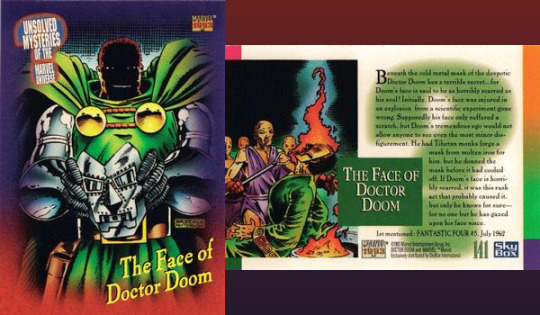
Starting off we’ve got the longest running mystery, but as with all of these the big question is “what were you hoping to find out?” We’ve seen Doom’s unscarred face in flashbacks and healed in the 1980s Secret Wars, but it was only in 2015’s reimagining of Secret Wars that we see what really lives under the mask. It’s nasty! A real “dead dove do not eat” moment.
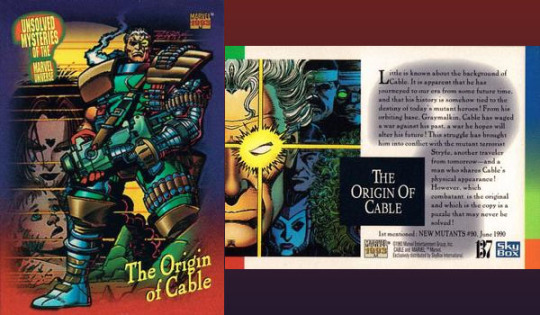
This one I’m surprised was a mystery since it’s so well known now. When Cable first showed up he was a warrior from the future, but it wasn’t until 1994’s The Adventures of Cyclops and Phoenix that it was revealed that he was the time traveling son of Scott Summers and Jean Grey. Well, kinda... you see he’s actually the son of Scott and Jean’s clone Madeline and… go ask Jay and Miles if you want the X-Men X-Plained.
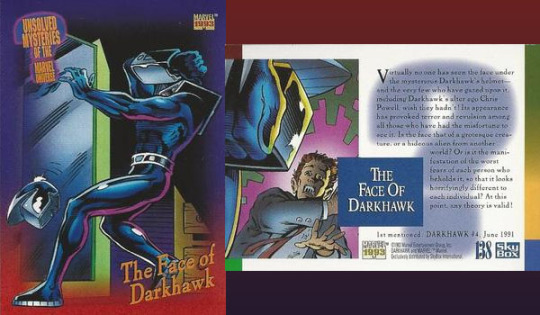
This is the one that got me started on this mess. Darkhawk wasn’t a huge character so this sort of went unresolved but also who cared? Basically when Chris Powell turns into Darkhawk his whole body is replaced by a drone robot from these space hawk warriors. Turns out the whole thing that freaked him out was that underneath the helmet it revealed that he wasn’t even human in that form. And yet, as far as I know we’ve never got a clear look at what he saw.
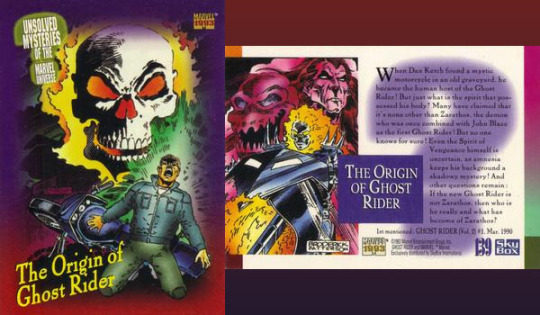
Hoo boy was this a mystery in 1993? So for background in 1990 we got Danny Ketch as the new Ghost Rider. He was more chains and leather than Johnny Blaze, the Evel Knievel-esque original. The mystery in question is “where did he get his powers and are they from the same demon Zarathos as the original?" After spending time too many wiki pages, I can now say that Danny was revealed to be Johnny Blaze’s secret brother and not powered by Zarathos. Looks like Danny at some point swapped his bike for a buster sword and started calling himself Death Rider. lol
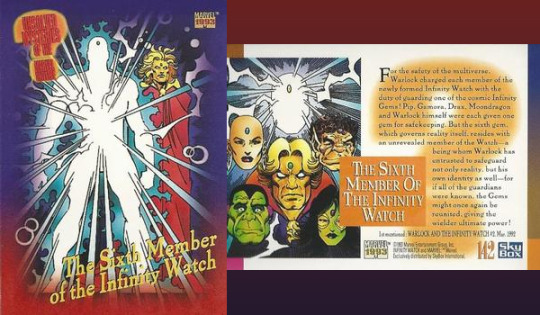
This one is easy! It’s Thanos! Thanos is the sixth member! It got revealed in The Warlock Chronicles during Infinity Crusade. This mystery didn’t make it out of 1993.
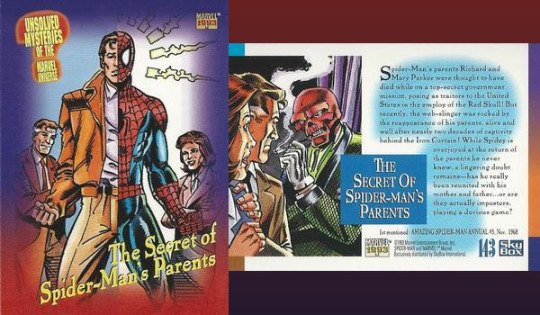
Oh hey it’s my least favorite Spider-Man topic! That his parents were killed by the fake communist Red Skull is pointless at best. That they were seemingly brought back only to be revealed as Spider-Slayer robots is somehow worse. That whole mess got resolved in 1994 as a plot from The Chameleon. It’s right before the Clone Saga. Ugh!

This one is a case of dragging it out so long that no answer would be good enough. In 2001’s “Origin” we finally found out that Logan’s real name is James Howlett and he was born in late-19th-century Canada. The Logan name comes from James’ maybereal father from an affair and definite first bone claw stabbing victim Thomas Logan. This is all fine but I 100% of the time confuse “James Howlett” with “Jamie Hewlett” the artist who draws The Gorillaz.
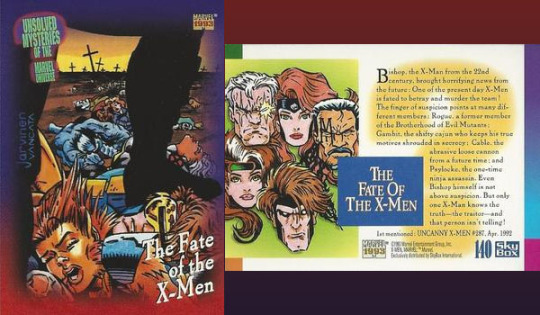
A major thread in 90s X-Men was that Bishop came from a future where an X-Man had betrayed the team and ruined the future. He was pretty suspicious of Gambit in particular and there were hints based on this guy named The Witness that seemed to be Gambit from the future. All that got dropped when Charles Xavier became Onslaught and turned on everyone. Bishop even kind of got to save the day in that story. I guess it all worked out.
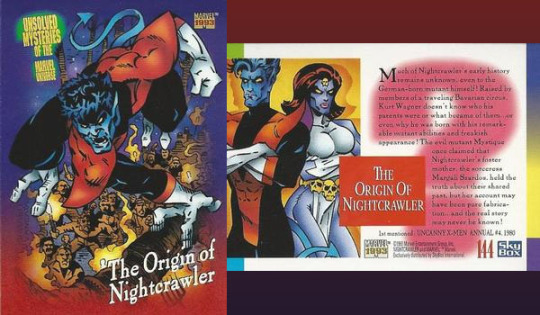
It’s our final X-Men mystery and the answer lies in one of the worst received X-Men stories of ALL-TIME! So your first thought should be “he’s a mutant what do you mean origin?” Okay, so starting in 1981 there were hints that Mystique was Nightcrawler’s mom. That started because people say they look the same. That’s a pretty wild thing to say since she has blue skin and he has blue fur and also she’s a shapeshifter so the idea of her real form is iffy at best. Well, it turns out Claremont wanted Mystique to have shapeshifted into a fella and been the father not the mother. Biologically speaking. He didn’t get to write that story, so instead Chuck Austen wrote The Draco…
I can’t believe this is going to a 2nd paragraph but here goes. Mystique in disguise as the wife of a German baron named Christian Wagner, but got pregnant by a mysterious Herr Azazel. The kid comes out blue and her charade is exposed. Flash forward to present day and Nightcrawler is investigating Isla des Demonas and he finally meets dear old dad. Azazel reveals himself to be a literal satan from the Brimstone Dimension. This very nearly broke Nightcrawler’s whole character. Instead of a kind man who is hated because of his appearance, he is a literal son of a demon. Don’t get me started on the woman who adopted Kurt. She’s green and has horns.
That's all the mysteries! If you think I got something wrong about X-Men then yes you're probably right. If there's a secret Darkhawk reveal I couldn't find them please please share it.
#nightcrawler#spider-man#thanos#darkhawk#wolverine#dr doom#ghost rider#x-men#marvel comics#1993#trading cards
23 notes
·
View notes
Text
The Last and Final Part 4/4
⦁ Rogue 2007 (This one has got to be one of my favorite killer croc movies set in the Australian outback) ⦁ Pitch Black 2000 (If you liked Doom then you'll love this sci-fi/horror film starring Vin Diesel) ⦁ National Treasure 2004 (A thrilling adventure film starring Nicholas Cage. If you liked Relic Hunter, you might enjoy this one) ⦁ There's Something About Mary 1998 (All the men are in love with Cameron Diaz in this wacky rom-com) ⦁ The Sisterhood of The Traveling Pants 2005 (A cult classic that keeps me smiling from ear to ear) ⦁ From Dusk till Dawn 1996 (A creepy film about killer vampires directed by Robert Rodriguez) ⦁ Drag Me to Hell (Also check out Sam Raimi's Evil Dead if you like horror) ⦁ Columbiana 2011 (Zoe Saldaña is absolutely badass in this action-packed thriller) ⦁ Chef 2014 (Food porn. All the food looked so good it had me salivating! A charming film starring Jon Favreau and Sofía Vergara) ⦁ Splice 2009 (A sci-fi film starring Adrien Brody performing controversial science experiments. This movie is not meant for sensitive viewers) ⦁ Fright Night (I never watched the original that was released in 1985 but this one starring Colin Farrel as the bad guy was pretty good) ⦁ The Beach (A film that you need to watch at least once starring Leonardo DiCaprio) ⦁ Gorgeous 1999 (A feel-good comedy/action film that is lighthearted starring Jackie Chan and Shu Qi) ⦁ National Security 2003 (A fun action film starring Martin Lawrence and Steve Zahn as security guards) ⦁ E.T Extraterrestrial 1982 (A charming alien film from director Steven Spielberg. We used to have the DVD at home, and I would watch it all the time) ⦁ A.I Artificial Intelligence 2001 (A futuristic fantasy film about a robot child that wants to become a real boy much like Pinocchio. A real gem of a movie that had me crying at the ending) ⦁ The Devil's Advocate 1997 (Keanu Reeves and Al Pacino as the devil. Need I say more?) ⦁ Interview With a Vampire 1994 (Brad Pitt and Tom Cruise as vampires. That's all I'm going to say) ⦁ Bicentennial Man 1999 (A touching film starring the late Robin Williams as a robot butler) ⦁ Norbit 2007 (Eddie Murphy as Rasputia was so funny you will laugh out loud!) ⦁ Malibu's Most Wanted 2003 (I might say this one is a guilty pleasure but so is everything else on this list) ⦁ Kung Fu Hustle 2004 (If you still haven't watched this please do. This wild lighthearted comedy makes for a good time) ⦁ Enter The Dragon 1973 (A Bruce Lee classic that is a must-see!) ⦁ Twinkle, Twinkle, Lucky Stars 1985 (Starring Summo Hung and Jackie Chan this is one of my favorite action comedies to watch) ⦁ The One 2001 (Jet Li playing multiple versions of himself was so cool) ⦁ Hide and Seek 2005 (Robert De Niro & Dakota Fanning were both great. You need to see this if you haven't) ⦁ The Rundown 2003 (Great action flick starring Dwayne Johnson) ⦁ Nacho Libre (Jack Black is so funny in this movie, it was really entertaining to watch) ⦁ John Tucker Must Die 2006 (A playful comedy that's fun to watch) ⦁ Shanghai Noon 2000 (Jackie Chan and Owen Wilson make such a fun duo) ⦁ Ghost Ship 2002 (Ghosts on a ship! Need a say more?) ⦁ Space Sweepers 2021 (A great Korean film 8/10! I liked it very much I just don't know why it took me so long to watch it) ⦁ Game of Death 1978 (A gripping action film starring the late martial artist Bruce Lee makes this another classic to watch) ⦁ Shaolin Soccer 2001 (Another fun comedy from Stephen Chow, the same director that gave us Kung Fu Hustle. This movie is equally hilarious) ⦁ Solo: A Star Wars Story 2018 (There are so many Star Wars movies and I enjoyed all of them but there are just too many to mention) ⦁ Star Trek 2009 (A solid movie in my opinion and a great franchise) ⦁ Letters To Juliet 2010 (I got to see this in the cinema and thought it was such a sweet rom-com) ⦁ Thor Ragnarok 2017 (Yes, I liked the first Thor movie, but I liked Ragnarok more)
We have finally reached a conclusion! Phew, it felt like that list went on forever! That was my version of memorable movies to watch, and I am quite satisfied with my selection. I added a lot more older movies to my list because I felt like they were better back then. Every new release that I've watched recently has fallen short of my expectations, the quality is just not the same as it was back then. Every time I watch a new movie it just feels like something is missing. Maybe my standards are just too high. I will say I am picky person when it comes to what I watch and invest my time in hence I've decided to stay away from films for now. I will stick to watching tv shows and hopefully 2024 has better options for us this year. If a new movie does however pique my interest, I will be sure to rave about it to everyone.
Thanks for reading and take care!
2 notes
·
View notes